Contents
- 1. User manual 1 of 4
- 2. User manual 2 of 4
- 3. User manual 3 of 4
- 4. User manual 4 of 4
User manual 2 of 4
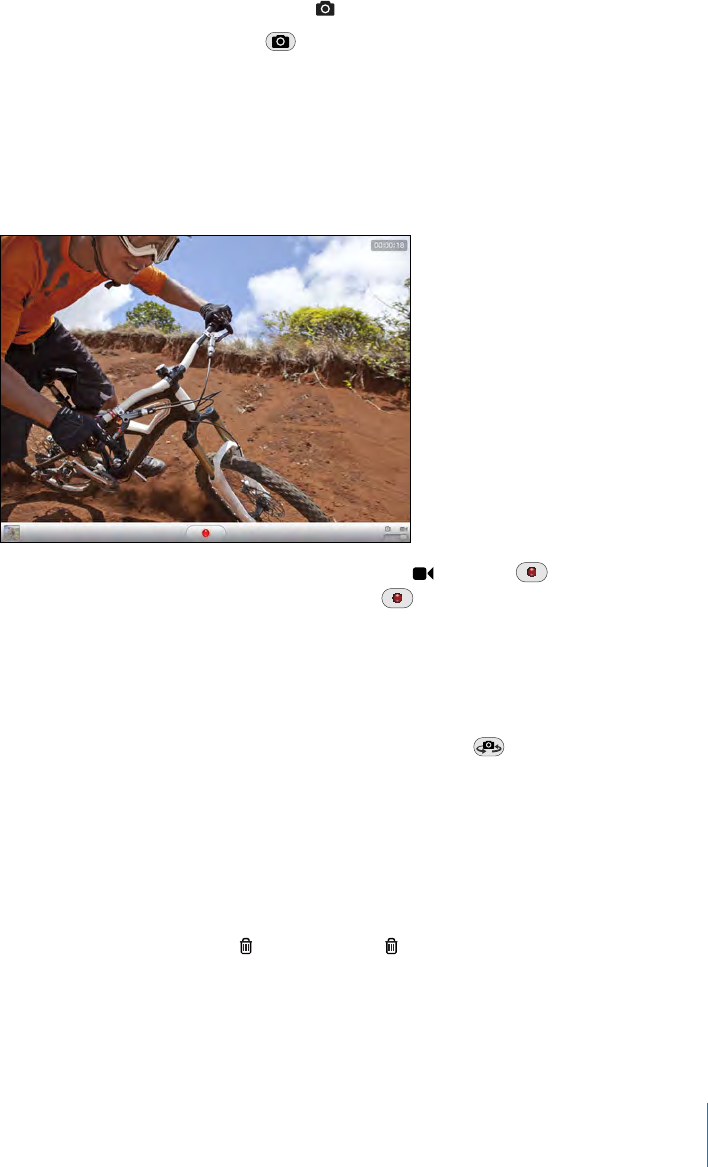
Taking Photos and Recording Videos
Taking photos and recording videos with iPad is as easy as pointing and tapping. Make
sure the Camera/Video switch is set to .
Take a photo: Aim iPad and tap .
When you take a photo or start a video recording, iPad makes a shutter sound. You can
use the volume buttons to control the volume of the shutter sound. You don’t hear a
sound if you set the Side Switch to silent. See “Buttons” on page 10.
Note: In some regions, the sound eects for Camera are played even if the Side Switch
is set to silent.
Record a video: Slide the Camera/Video switch to , then tap to start recording.
The record button blinks while you record. Tap again to stop recording.
Change the focus area and set the exposure: Tap where you want to focus or set the
exposure. Camera adjusts the exposure for the selected area of the image.
Zoom in or out: Tap the screen, then drag the slider at the bottom to zoom in or out
(back camera, in camera mode only).
Switch between the front camera and back camera: Tap in the upper-right
corner of the screen.
Review a photo or video you’ve just taken: Tap the thumbnail of your last shot, in the
lower-left corner of the screen.
Use the left and right arrows at the bottom of the screen to review other photos and
videos in the Camera Roll, or just ick left or right. Tap Done to return to camera or
video mode. If you don’t see the controls, tap the screen to display them.
Delete a photo or video: Tap . If you don’t see , tap the screen to display the controls.
Take a screenshot: Quickly press and release both the Sleep/Wake button and the
Home button. The screen ashes when the screenshot is taken, and the screenshot is
added to the Camera Roll album.
61
Chapter 6 Camera

Viewing and Sharing Photos and Videos
The photos and videos you take with Camera are saved in the Camera Roll album on
iPad. You can view the Camera Roll album from either Camera or Photos.
View photos and videos in the Camera Roll album: In Camera, tap the thumbnail
image in the lower-left corner of the screen. In Photos, tap the Camera Roll album. Tap
the left or right button, or ick left or right to ip through the photos and videos.
When viewing a photo or video in the Camera Roll album, tap the screen to display
the controls.
For more information about viewing and sharing photos and videos, see:
“ ÂViewing Photos and Videos” on page 70
“ ÂSharing Photos” on page 73
Trimming Videos
You can trim the frames from the beginning and end of a video that you just recorded,
or any other video in the Camera Roll album. You can replace the original video or save
the trimmed version as a new video clip.
Trim a video:
1 While viewing a video, tap the screen to display the controls.
2 Drag either end of the frame viewer at the top of the video, then tap Trim.
3 Tap Trim Original or “Save as New Clip.”
Important: If you choose Trim Original, the trimmed frames are permanently deleted
from the original video. If you choose “Save as New Clip,” a new trimmed video clip is
saved in the Camera Roll album and the original video is unaected.
Uploading Photos and Videos to Your Computer
You can upload the photos and videos you take with Camera to photo applications on
your computer, such as iPhoto on a Mac.
Upload photos and videos to your computer: Connect iPad to your computer.
ÂMac: Select the photos and videos you want and click the Import or Download
button in iPhoto or other supported photo application on your computer.
ÂPC: Follow the instructions that came with your photo application.
If you delete the photos and videos from iPad when you upload them to your
computer, they’re removed from the Camera Roll album. You can use the Photos
settings pane in iTunes to sync photos and videos (videos can be synced with Macs
only) to the Photos app on iPad.
62 Chapter 6 Camera

FaceTime 7
About FaceTime
FaceTime lets you make video calls over Wi-Fi. Use the front camera to talk face-to-face,
or the back camera to share what you see around you.
To use FaceTime, you need iPad 2 and a Wi-Fi connection to the Internet. The person
you call must also have a device or computer that works with FaceTime. For more
information, see “FaceTime” on page 169.
Note: FaceTime may not be available in all countries or regions.
63

Signing In
To use FaceTime, you need an Apple ID. If you have an iTunes Store account, MobileMe
account, or other Apple account, you can use that Apple ID with FaceTime. If you don’t
have an Apple ID, you can create one when you open FaceTime.
You don’t need to sign in or out every time you use FaceTime. Once you sign in, you
can start a FaceTime call right away.
Sign in to FaceTime:
1 Open FaceTime, enter your Apple ID and password, then tap Sign In. If you don’t
already have an Apple account, you can tap Create New Account and set one up now.
2 On the FaceTime screen, enter the email address others should use to call you in
FaceTime, then tap Next. If this is the rst time you’ve used this address for FaceTime,
you may need to check for new email in that account and reply to the conrmation
message from Apple. (If you’ve already added the account to Mail on iPad, verication
is automatic.)
Now you can choose a contact and start a FaceTime call, and others can call you using
the email address you provided. If you use more than one email address, you can add
the others as described below.
Create a new account:
1 Open FaceTime and tap Create New Account.
2 Follow the onscreen instructions. The email address you enter will be the Apple ID for
the new account.
3 On the FaceTime screen, enter the email address you want others to use to call you.
This address doesn’t need to be the same as the address you entered for your Apple ID,
but it must be a working email address.
4 Reply to the conrmation email sent from Apple to the email address you entered in
the previous step.
If you have more than one email address, you can let people call you using any of them.
Add email addresses: Choose Settings > FaceTime, then tap Add Another Email.
Sign out: You don’t normally need to sign out of FaceTime—just sign in once,
and open FaceTime later without being asked to sign in again. You can’t receive
FaceTime calls while you’re signed out. But if you do need to sign out, choose
Settings > FaceTime, then tap Account.
Turn o FaceTime: If you don’t want to receive FaceTime calls, choose Settings >
FaceTime and turn o FaceTime.
64 Chapter 7 FaceTime

Making a FaceTime Call
To make a FaceTime call, open the FaceTime app, then choose someone from your
contacts, favorites, or list of recent calls.
Call a contact: Tap Contacts, choose a name, then tap the email address or phone
number they use with FaceTime.
Add a contact: Tap Contacts, tap , then enter the person’s name and their email
address or phone number. For a contact outside your region, be sure to enter
the complete number, including country code and area code—for example,
+1 (408) 555-1234 in the United States.
Restart a recent call: Tap Recents, then choose a name or number.
Call a favorite: Tap Favorites, then tap a name in the list.
While You’re Talking
While talking to someone in FaceTime, you can switch cameras, change camera
orientation, mute your microphone, move your picture-in-picture display, open
another application, and nally, end your call.
Switch between the front and back cameras: Tap .
Change camera orientation: Rotate iPad. The image your friend sees changes to match.
To avoid rotating the screen as you move the camera around, turn on the orientation
lock. See “Viewing in Portrait or Landscape” on page 16.
Mute your microphone: Tap . Your friend can still see you, and you can still see and
hear your friend.
Move your picture-in-picture display: Drag the small window to any corner.
Use another application during a call: Press the Home button, then tap an
application icon. You can still talk with your friend, but you can’t see each other. To
return to the video, tap the green bar at the top of the screen.
End the call: Tap .
65
Chapter 7 FaceTime

Photo Booth 8
About Photo Booth
It’s easy to take a photo using Photo Booth. Make your photo more interesting by
applying an eect when you take it. Photo Booth works with both the front and
back cameras.
Selecting an Eect
Before you take a picture, you can select an eect to apply to the picture.
Select an eect: Tap , then tap the eect you want to use.
Distort an image: If you select a distortion eect, drag your nger across the screen
to change the distortion. You can also pinch, swipe, or rotate the image to change
the distortion.
66

Taking a Photo
To take a Photo Booth photo, simply aim iPad and tap.
Take a photo: Aim iPad and tap .
When you take a photo, iPad makes a shutter sound. You can use the volume buttons
on the side of the iPad to control the volume of the shutter sound. You won’t hear a
sound if you set the Side Switch to silent. See “Buttons” on page 10
Note: In some regions, the sound eects are played even if the Side Switch is set
to silent.
Switch between the front and back cameras: Tap at the bottom of the screen.
Review the photo you’ve just taken: Tap the thumbnail of your last shot. Swipe left or
right to view more thumbnails.
If you don’t see the controls, tap the screen to display them.
Delete a photo: Select a thumbnail, then tap .
Manage photos: Tap the thumbnail of the photo—you can select more than one.
Tap , then tap Email, Copy, or Delete.
Viewing and Sharing Photos
The photos you take with Photo Booth are saved in the Camera Roll album on iPad.
You can view the Camera Roll album in the Photos app.
View photos in the Camera Roll album: In Photos, tap the Camera Roll album. To ip
through the photos, tap the left or right button, or swipe left or right.
You can use Mail to send a Photo Booth photo in an email message.
Send a photo: Tap a thumbnail to select the photo, or tap again to select more than
one photo. Tap , then tap the Email button at the bottom of the screen.
Mail opens and creates a new message with the photo attached.
67
Chapter 8 Photo Booth

Uploading Photos to Your Computer
Upload the photos you take with Photo Booth to photo applications on your
computer, such as iPhoto on a Mac.
Upload photos to your computer: Connect iPad to your computer.
ÂMac: Select the photos to upload, then click the Import or Download button in
iPhoto or other supported photo application on your computer.
ÂPC: Follow the instructions that came with your photo application.
If you delete the photos from iPad when you upload them to your computer, they’re
removed from the Camera Roll album. You can use the Photos settings pane in iTunes
to sync photos to the Photos app on iPad.
68 Chapter 8 Photo Booth

Photos 9
About Photos
iPad lets you carry photos and videos with you so you can enjoy them wherever you
are. You can easily share them with family and friends, either directly on iPad, or on an
HDTV using AirPlay and Apple TV. You can even print photos from iPad using AirPrint.
If your iPad has a camera, you can view photos and videos as you take them. You can
sync photos and videos from your computer, import them from a digital camera or
iPhone, or save them from email or the web. Use them in apps, send them in email
messages, or upload them to your MobileMe Gallery. You can use iPad as a photo
frame that displays an animated slideshow of your images.
Syncing Photos and Videos with Your Computer
iPad supports standard photo formats such as JPEG, TIFF, GIF, and PNG. You use iTunes
to sync photos to iPad. When syncing photos to iPad, iTunes automatically creates a
size optimized for iPad, if necessary. See “Setting Up Syncing” on page 24.
iPad supports H.264 and MPEG-4 video formats, with AAC audio. You use iTunes to
sync videos taken with a digital camera, iPhone, or iPod touch (4th generation) to iPad.
69

Importing Photos and Videos from iPhone or a Digital Camera
With the iPad Camera Connection Kit (sold separately), you can import photos and
videos directly from a digital camera or iPhone, or from an SD memory card.
Import photos:
1 Insert the SD Card Reader or Camera Connector, included in the iPad Camera
Connection Kit, into the iPad dock connector.
To connect a camera or iPhone, use the USB cable that came with the camera or Â
iPhone, and connect it to the USB port on the Camera Connector. If you’re using
iPhone, make sure it’s turned on and unlocked. To connect a camera, make the sure
the camera is turned on and in transfer mode. For help, see the documentation that
came with the camera.
To use an SD memory card, insert it in the slot on the SD Card Reader. Don’t force Â
the card into the slot; it ts only one way.
For more information about the connectors, see the iPad Camera Connection Kit
documentation.
2 Unlock iPad.
3 The Photos app opens and displays the photos and videos that are available for
importing.
4 Select the photos and videos you want to import.
To import all of the items, tap Import All. Â
To import just some of the items, tap the ones you want to include (a checkmark Â
appears on each), then tap Import, and select Import Selected.
5 After the photos are imported, you can choose to keep or delete the photos and
videos on the card, camera, or iPhone.
6 Disconnect the SD Card Reader or Camera Connector.
To view the photos, look in the Last Import album. A new Event contains all the photos
that were selected for import.
To transfer the photos to your computer, connect iPad to your computer and import
the images with a photo application such as iPhoto or Adobe Elements.
Viewing Photos and Videos
Photos lets you view photos synced from your computer’s photo application, imported
from a digital camera or iPhone, or saved from an email message or webpage.
Photos organizes collections by Albums, Events, Faces, and Places. Places uses
the location information encoded in photos, but not all photos may have this
information—it requires a camera that supports geotagging. Events and Faces must
rst be congured in iPhoto or Aperture on a Mac, then synced to iPad.
70 Chapter 9 Photos
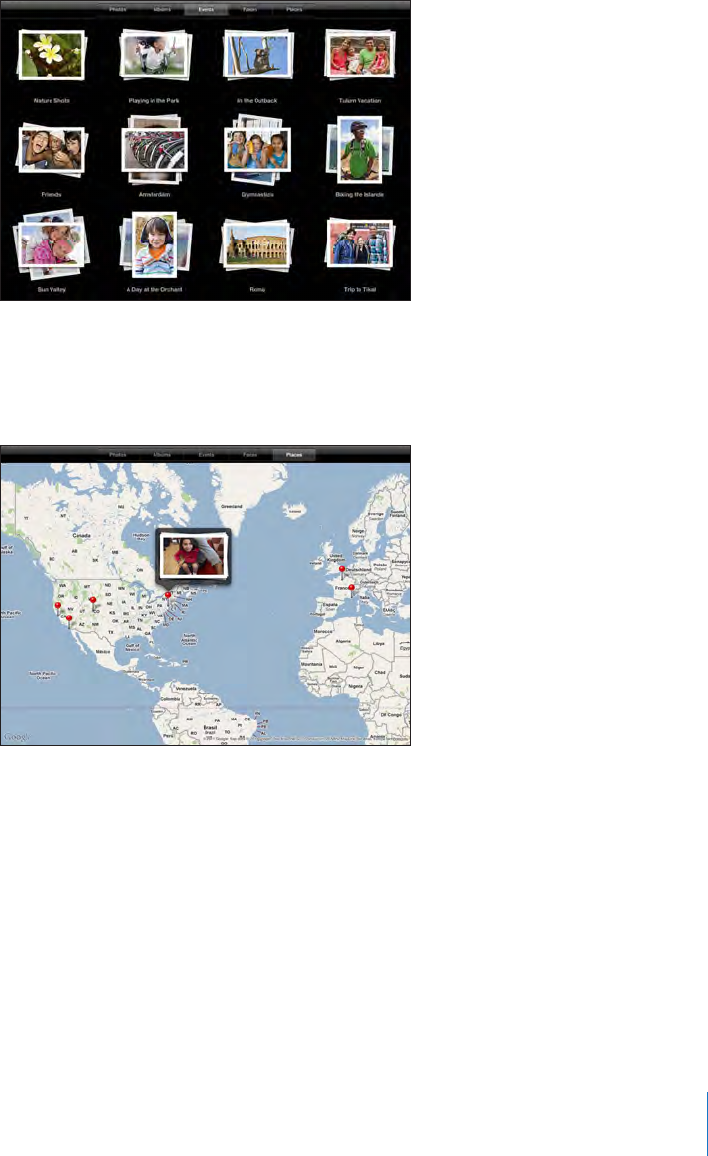
View photos:
1 In Photos, tap Photo, Albums, Events, Faces, or Places.
To open a collection, tap it. Or, pinch the collection to spread out a preview of the
photos it contains, then let go to open it. Photos are sorted by creation date.
When you’re viewing Places, tap a pin on the map to display the location, then pinch
to zoom and show all photos taken at this location.
2 Tap a thumbnail to view a photo in full screen.
You can also pinch to zoom in on the photo.
71
Chapter 9 Photos

Show or hide the controls: Tap the photo to show the controls. Tap again to hide
the controls.
View a photo in landscape orientation: Rotate iPad sideways. The photo or video
resizes automatically to t the screen.
Zoom in on part of a photo: Double-tap where you want to zoom in. Double-tap
again to zoom out. You can also pinch to zoom in or out.
Pan a photo: Drag the photo.
See the next or previous photo: Flick left or right. Or tap the screen to show the
thumbnails across the bottom, then tap or drag to view a dierent photo.
Delete a photo: You can delete photos from the Saved Photos album, which contains
photos you save from email or the web. For photos synced from your computer, you
need to delete the photo from the album on your computer, then sync iPad again.
72 Chapter 9 Photos

Rotate a photo: Tap . To rotate it more, tap again.
View photos or videos on a TV using AirPlay and Apple TV: Make sure iPad is on the
same wireless network as Apple TV, then tap and choose Apple TV from the list.
When you ick through photos on iPad, the video on the TV updates as you pause.
See “Using AirPlay” on page 45 for more information.
Sharing Photos
You can share your photos as slideshows, complete with music and transitions. With
AirPlay and Apple TV, you can wirelessly stream your photos to a TV. You can send
photos and videos in email messages, and add photos to your MobileMe Gallery. You
can also copy and paste photos, save photos from email messages to Photos, and save
images from webpages to a photo album.
Slideshows
You can create and view a slideshow that shows your photos with transitions and
music. You can view a slideshow on iPad, or stream it wirelessly to an Apple TV. You can
also use iPad to view a slideshow on an external display, such as a projector.
View a slideshow:
1 Tap an album to open it.
You can select an album that contains photos, videos, or both. If your iPad has a
camera, photos and videos you’ve shot appear in the Camera Roll album.
2 Tap the Slideshow button and, in the list that appears, select slideshow options. You can:
Select a song from your music library to play music during the slideshow. Â
Select a transition eect that plays between photos. Â
To set how long each photo is displayed, go to General > Settings > Photos. You can
also set whether the slideshow repeats, or plays in a random sequence.
Available transitions are determined by how you view the slideshow. If you’re
connected to an Apple TV, choose one of the available transitions. If iPad is connected
to a TV or projector using a video cable, choose the Dissolve transition. For information
about connecting to an external display, see Chapter 10, “ Videos,” on page 77.
3 Tap Start Slideshow.
To stop the slideshow, tap the screen.
If you’re using AirPlay to stream the photos to an Apple TV, tap and select the
Apple TV from the list. See “Using AirPlay” on page 45 for more information.
Sending a Photo or Video in an Email Message
Send a photo or video: Tap a photo or video, tap , then tap Email Photo.
If you don’t see , tap the screen to show the controls.
73
Chapter 9 Photos

Send multiple photos or videos: Tap an album, then tap . Tap each of the photos
or videos you want to send (a checkmark appears on each thumbnail), then tap Email.
If the Email button is unavailable, select fewer items.
Copy a photo or video:
1 Tap .
2 Tap to select the photo or video you want to copy.
3 Tap Copy.
Paste a photo or video: Tap to place the insertion point where you want to paste the
photo or video, then tap the insertion point and tap Paste.
Adding a Photo or Video to a MobileMe Gallery
If you’re a MobileMe subscriber, you can add photos and videos from iPad to your
MobileMe Gallery. You can also add items to someone else’s MobileMe Gallery if they
allow email contributions.
Before you can add photos to a gallery in your MobileMe account, you must:
Set up your MobileMe account on iPad. If you don’t have a MobileMe account, Â
go to www.apple.com/mobileme/setup/ipad.html.
Publish a MobileMe Gallery and allow adding photos from email or iPad. Â
Add a photo or video to your gallery: Choose a photo or video and tap , then tap
“Send to MobileMe.” Enter a title and description if you like, select the album to add
the photo to, then tap Publish.
If you don’t see , tap the screen to show the controls.
iPad tells you when the photo has been published, and gives you options to view it on
MobileMe or email a link to a friend.
Add a photo to someone else’s gallery: Choose a photo and tap , then tap “Email
Photo.” Enter the album’s email address, then click Send.
Saving Photos from Email Messages or Webpages
Save a photo from an email message to your Saved Photos album: Tap the photo,
then tap Save Image. If the photo hasn’t been downloaded, tap the download icon rst.
Save a photo from a webpage to your Saved Photos album: Touch and hold the
photo, then tap Save Image.
Copy photos from the Saved Photos album to your computer: Connect iPad to your
computer’s USB port, then use a photo application, such as iPhoto on a Mac, to copy
the images.
74 Chapter 9 Photos

Assigning a Photo to a Contact
You can assign a photo to a contact.
Assign a photo to a contact:
1 Choose a photo on iPad, then tap .
2 Tap “Assign to Contact,” then choose a contact.
3 Drag the photo to pan, and pinch to zoom in or out, until the photo looks the way
you want.
4 Tap Set Photo.
In Contacts, you can assign a photo to a contact by tapping Edit and then tapping
the picture icon.
Printing Photos
You can use AirPrint to print photos from iPad.
Print a photo: Tap , then tap Print. Tap Select Printer to select a printer and set
printer options such as the number of copies, then tap Print. If your printer has a tray
for photo paper, it may automatically switch to that tray when you print a photo.
For more information, see “Printing” on page 40.
Wallpaper and Lock Screen Photos
You can display a photo in the wallpaper background of the Lock screen and Home
screen. You can choose from several wallpaper pictures included with iPad, or you can
use a photo of your own.
Set a photo as screen wallpaper:
1 Choose any photo and tap , then tap Use As Wallpaper.
2 Drag to pan the photo, or pinch the photo to zoom in or out, until it looks the way you
want. A photo that’s at least 1024 x 1024 pixels lls the screen when iPad is rotated.
3 Tap Set Wallpaper. Then tap to use the image as wallpaper for the Home screen, on the
Lock screen, or both.
To choose from several wallpaper pictures included with iPad, go to Settings >
Brightness & Wallpaper.
75
Chapter 9 Photos

Using Picture Frame
When iPad is locked, you can display an album of photos. This is a great way to enjoy
iPad while charging it in an iPad Dock.
To change Picture Frame settings, go to Settings > Picture Frame, then set any of the
following options:
The transition you select is played between photos. The duration of the slideshow Â
can’t be changed.
Picture Frame can zoom the image to focus on faces in the image. It can also Â
randomly select one of the faces as the center of focus, if more than one face is
present in the image. Picture Frame uses the face identication information in
photos imported from iPhoto or Aperture on a Mac. Zooming in on faces isn’t an
option with the Origami transition.
Picture Frame can display all photos, or just those in an Album, Faces, or Event Â
category. Select an option, then rene your selection in the list that appears. The
Faces, Albums, and Event selections are the same as those in the Photos app.
Start or stop Picture Frame:
1 Press the Sleep/Wake button to lock iPad.
2 On the Lock screen, tap .
3 Tap the screen to pause the slideshow, then tap to return to the Lock screen,
or slide the slider to unlock iPad.
To turn o Picture Frame, go to Settings > General > Passcode Lock.
76 Chapter 9 Photos

Videos 10
About Videos
You can use iPad to view movies, music videos, video podcasts, and, if they’re available
in your area, TV shows. iPad also supports special features such as chapters, subtitles,
alternate audio, and closed captioning.
You can rent or purchase videos from the iTunes Store, and you can use a video
adapter cable to watch videos on a TV or projector. If you have an Apple TV, you can
use AirPlay to watch the videos wirelessly on a TV.
77
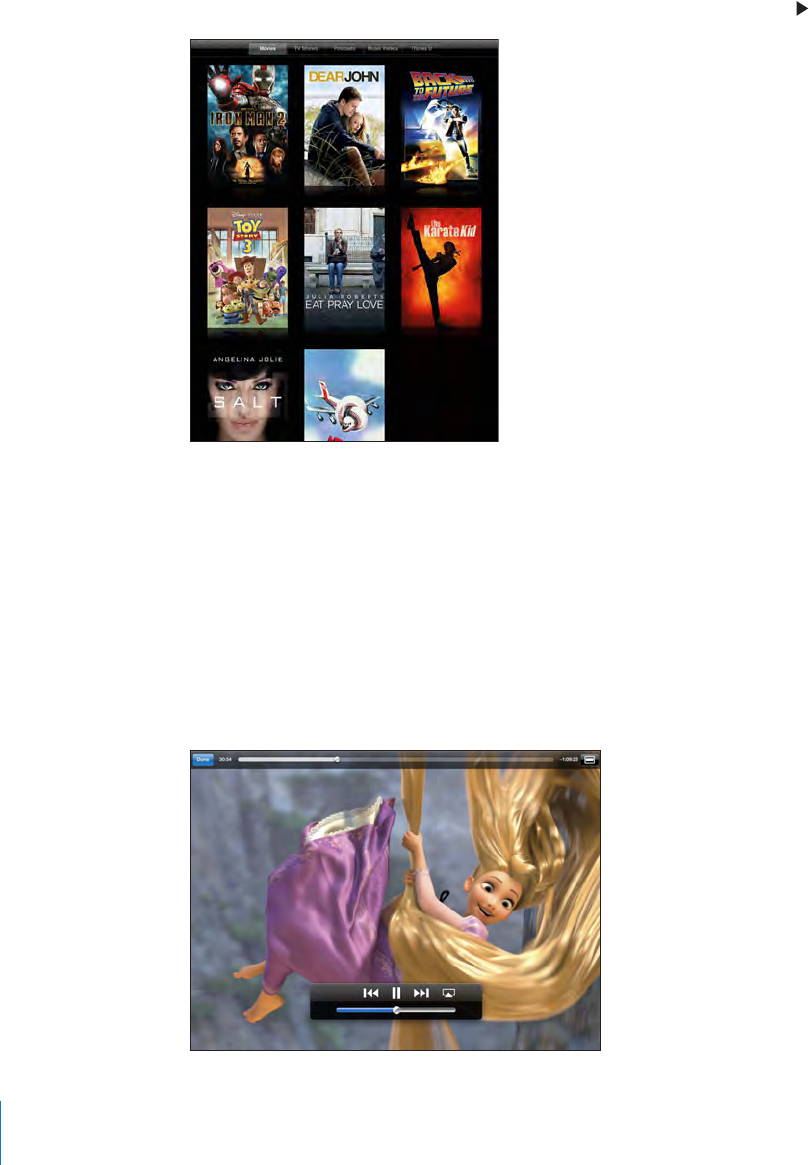
Playing Videos
Play a video: Tap Videos, then tap a category of videos, such as Movies. Tap the video
you want to watch. If the video has chapters, tap a chapter title, or just tap .
Display playback controls: While a video is playing, tap the screen to show the
controls. Tap again to hide them.
Controlling Video Playback
Rotate iPad to play videos in widescreen orientation and take full advantage of
the display.
Drag the playhead along the scrubber bar to skip to any point in the video. To adjust
the scrub rate from fast to slow, slide your nger down as you drag the playhead along
the scrubber bar.
78 Chapter 10 Videos
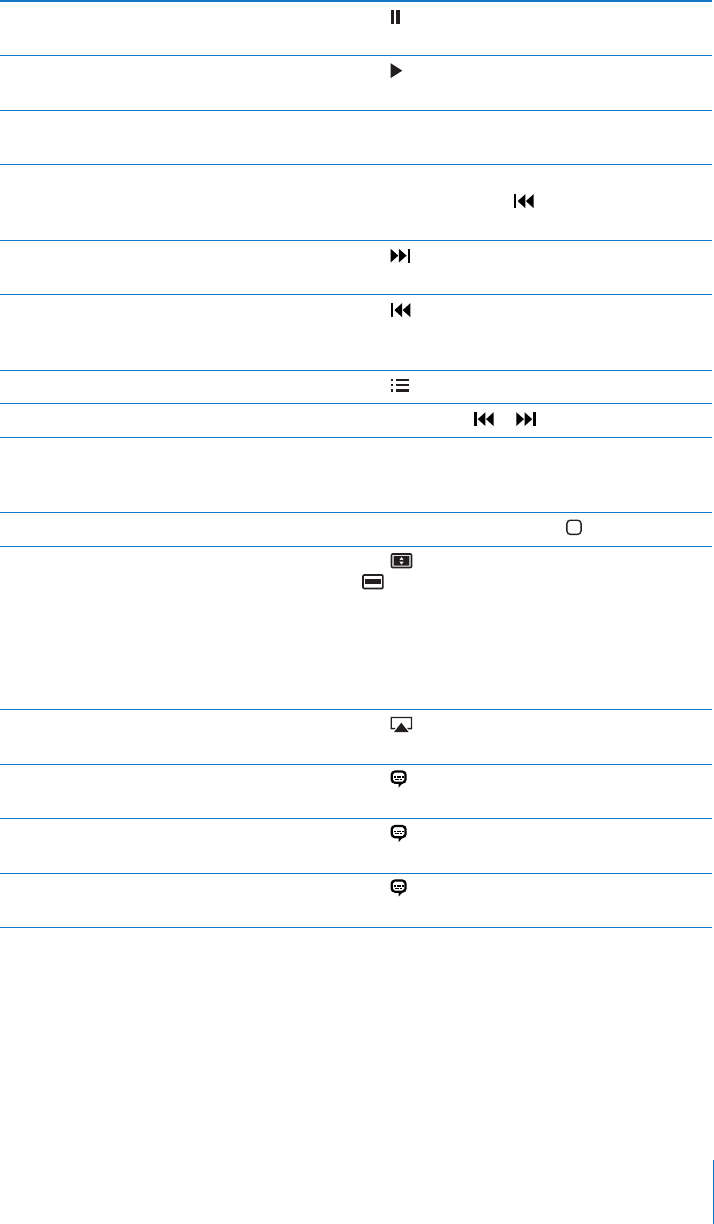
Pause a video Tap or press the center button (or equivalent
button) on a compatible headset.
Resume playback Tap or press the center button (or equivalent
button) on a compatible headset.
Raise or lower the volume Drag the volume slider, or use the iPad volume
buttons or the buttons on a compatible headset.
Start a video over Drag the playhead on the scrubber bar all the
way to the left, or tap if the video doesn’t
contain chapters.
Skip to the next chapter (if available) Tap or press the center button (or equivalent
button) on a compatible headset twice quickly.
Go to the previous chapter (if available) Tap or press the center button (or equivalent
button) on a compatible headset three times
quickly.
Start playing at a specic chapter (if available) Tap , then choose a chapter from the list.
Rewind or fast-forward Touch and hold or .
Skip to any point in a video Drag the playhead along the scrubber bar. Slide
your nger down to adjust the scrub rate from
fast to slow.
Stop watching a video before it nishes playing Tap Done, or press the Home button.
Scale a video to ll the screen or t to the
screen
Tap to make the video ll the screen, or tap
to make it t the screen. You can also double-
tap the video to switch views.
When you scale a video to ll the screen, the
sides or top may be cropped. When you scale it
to t the screen, you may see black bars on the
sides or above and below the video.
Play a video on Apple TV using AirPlay Tap and choose an Apple TV. See “Watching
Videos on a TV” on page 80.
Select a dierent audio language (if available) Tap , then choose a language from the Audio
list.
Show or hide subtitles (if available) Tap , then choose a language, or O, from the
Subtitles list.
Show or hide closed captioning (if available) Tap to show or hide captions, if the movie has
them.
Syncing Videos
Use iTunes to sync videos to iPad. When iPad is connected to your computer, use the
Movies, TV Shows, Podcasts, and iTunes U panes to select which videos to sync.
79
Chapter 10 Videos

Watching Rented Movies
You can rent movies in standard or high denition format from the iTunes Store and
watch them on iPad. You can download rented movies on iPad, or transfer them from
iTunes on your computer to iPad. (Rented movies aren’t available in all regions.)
A movie must be completely downloaded before you can watch it. You can pause a
download and continue it later. Rented movies expire after a certain number of days,
and once you start a movie, you have a limited amount of time to nish watching it.
Movies are automatically deleted when they expire. Before renting a movie, check the
iTunes Store for the expiration time.
View a rented movie: Choose Videos, tap the Movies category, then tap the movie
you want to watch. Select a chapter, or just tap .
Transfer rented movies to iPad: Connect iPad to your computer. Then select iPad in
the iTunes sidebar, click Movies, and select the rented movies you want to transfer.
Your computer must be connected to the Internet. Movies rented on iPad cannot be
transferred to a computer.
Watching Videos on a TV
To watch videos on a TV, you can connect iPad using AirPlay and Apple TV, or use a
cable to connect iPad directly to your TV or AV receiver. For more information about
connecting iPad to a TV or projector, see “Video” on page 168.
Connect using AirPlay: Start video playback, then tap and choose your Apple TV
from the list of AirPlay devices. See “Using AirPlay” on page 45 for more information.
While video is playing, you can exit Video and use other apps.
To return playback to iPad: Open Videos, then tap and choose iPad from the list.
Deleting Videos from iPad
To save space, you can delete videos from iPad.
Delete a video: In the videos list, tap and hold a movie until the delete button
appears, then tap . Tap Cancel or Home when you nish deleting videos.
When you delete a video (other than rented movies) from iPad, it isn’t deleted from
your iTunes library on your computer, and you can sync the video back to iPad later.
If you don’t want to sync the video back to iPad, set iTunes to not sync the video. See
“Syncing with iTunes” on page 24.
Important: If you delete a rented movie from iPad, it’s deleted permanently and can’t
be transferred back to your computer.
80 Chapter 10 Videos

YouTube 11
Finding and Viewing Videos
YouTube features short videos submitted by people from around the world.
You can watch the latest, most popular videos, search for videos about topics of
interest, ag your favorites, and quickly access videos that you upload to YouTube
from your computer.
To use certain YouTube features on iPad, you need to sign in to a YouTube account
when prompted. For information about requirements and how to get a YouTube
account, go to www.youtube.com.
Note: YouTube isn’t available in all languages and locations.
To use YouTube, iPad must have an Internet connection. See “Connecting to the
Internet” on page 29.
Browse videos: Tap a button in the toolbar to select a category.
ÂFeatured: Videos reviewed and featured by YouTube sta.
ÂTop Rated: Videos most highly rated by YouTube viewers. You can rate videos on
iPad, if you have a YouTube account.
ÂMost Viewed: Videos most seen by YouTube viewers. Tap All for all-time most viewed
videos, or Today or This Week for most-viewed videos of the day or week.
ÂFavorites: Videos you added to Favorites. When you sign in to a YouTube account,
account favorites appear.
ÂMost Recent: Videos most recently submitted to YouTube.
ÂSubscriptions: Videos from YouTube accounts you subscribe to. You must be signed
in to a YouTube account to use this feature.
81

ÂPlaylists: Videos you add to playlists. You must be signed in to a YouTube account to
use this feature.
ÂMy Videos: Videos that you’ve upload to YouTube. You must be signed in to a
YouTube account to use this feature.
ÂHistory: Videos you’ve viewed most recently.
Search for a video:
1 Tap the YouTube search eld.
2 Type a word or phrase, then tap Search.
YouTube shows results based on searching video titles, descriptions, tags, and user
names. Each search result shows the title, rating, number of views, length, and the
name of the account the video was posted from.
Play a video: Tap the video.
The video begins downloading to iPad, and a progress bar appears. When enough of
the video has downloaded, it begins to play. You can also tap to start the video.
82 Chapter 11 YouTube
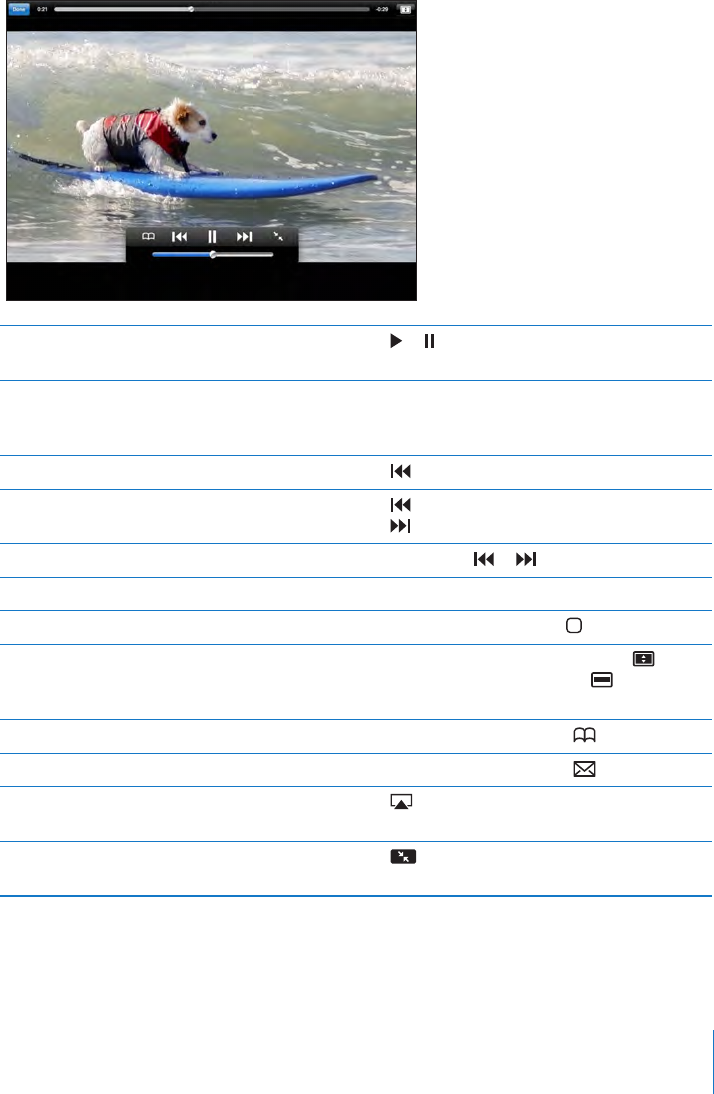
Controlling Video Playback
Rotate iPad to landscape orientation to view the video at its maximum size. When a
video is playing, the controls disappear so they don’t obscure the video.
Show or hide the video controls: Tap the screen.
Play or pause a video Tap or . You can also press the center button
(or equivalent button) on a compatible headset.
Adjust the volume Drag the volume slider, or use the iPad volume
buttons or the volume buttons on a compatible
headset.
Start a video over Tap .
Skip to the next or previous video in a list Tap twice to skip to the previous video.
Tap to skip to the next video.
Rewind or fast-forward Touch and hold or .
Skip to any point in a video Drag the playhead along the scrubber bar.
Stop watching a video Tap Done, or press the Home button.
Toggle between full-screen and standard mode Double-tap the video. You can also tap to
make the video ll the screen, or to make it
t the screen.
Add a video to Favorites Start playing a video, then tap .
Email a link to the video Start playing a video, then tap .
Play a video on Apple TV using AirPlay Tap and choose Apple TV. For information, see
“Using AirPlay” on page 45.
View information about a video Tap to exit full-screen mode and view related
videos, comments, and more controls.
83
Chapter 11 YouTube
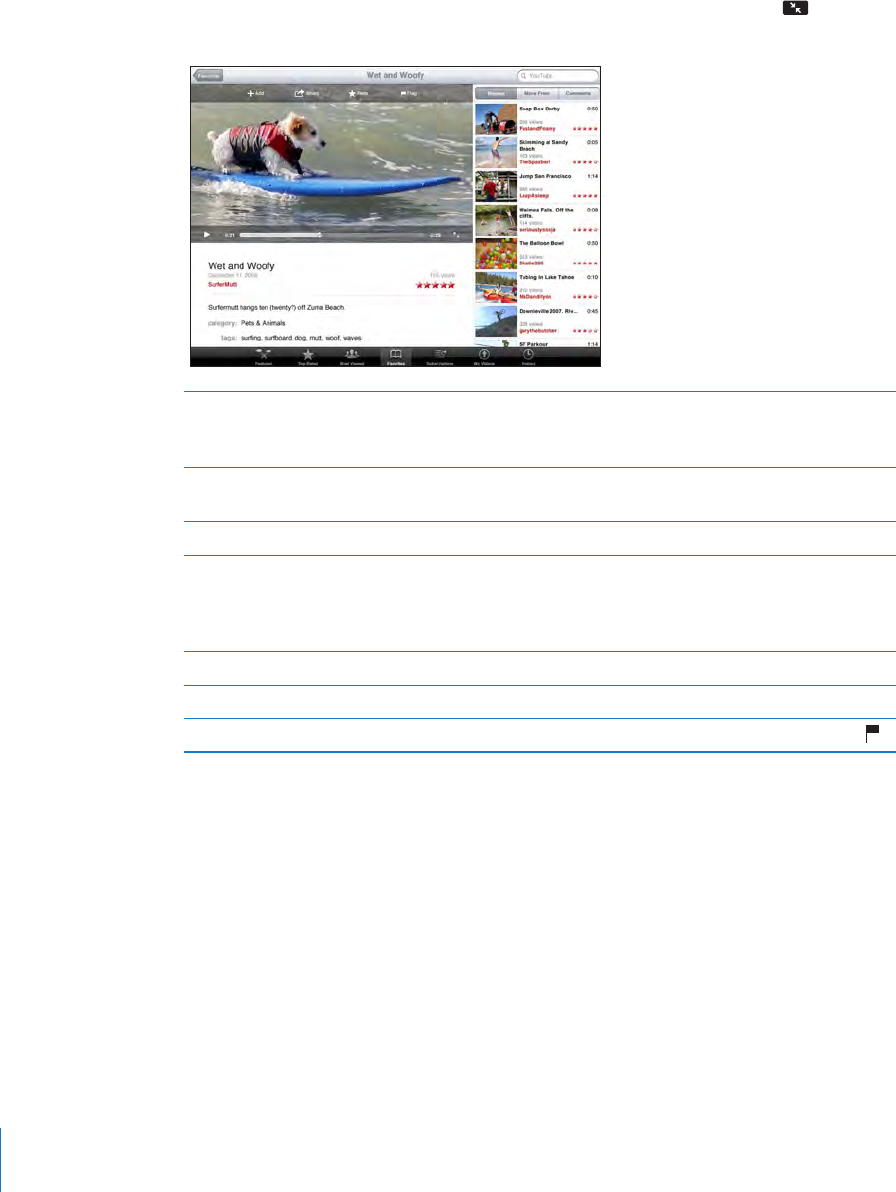
Managing Videos
While watching a full-screen video, tap to display the controller, then tap to see
related videos and options for managing videos.
Rate a video or add a comment Tap the video to display the toolbar, then tap
Rate and select a rating. You must be signed in to
a YouTube account.
See more videos from this YouTube user In the sidebar, tap “More From.” You must be
signed in to a YouTube account.
See videos similar to this one In the sidebar, tap “Related.”
Subscribe to videos by this YouTube user On the More Info screen, tap More Videos, then
tap “Subscribe to <account>” at the bottom
of the video list. You must be signed in to a
YouTube account.
Add a video to Favorites or a playlist Tap Add, then select Favorites or a playlist.
Email a link to a video Tap Share.
Flag a video Tap the movie to display the toolbar, then tap .
Watching YouTube on a TV
If you have an Apple TV, you can use AirPlay to watch YouTube videos on a TV. See
“Controlling Video Playback” on page 83.
You can also connect iPad directly to your TV or a projector, and watch YouTube on
the large screen. For more information about using iPad with a TV or projector, see
“Video” on page 168.
84 Chapter 11 YouTube

Calendar 12
About Calendar
iPad makes it easy to stay on schedule. You can view calendars individually, or several
calendars at once. You can view your events by day, week, or month, or in a list. You
can also search events by title, invitee, or location.
You can sync iPad with the calendars on your computer. You can also create, edit,
or cancel events on iPad, and sync them back to your computer. You can subscribe
to Google, Yahoo!, or iCal calendars. You can subscribe to read-only iCalendar (.ics)
calendars or import .ics les from email. If you have a Microsoft Exchange account or a
supported CalDAV account, you can receive and respond to meeting invitations from
others, and invite people to events you’ve scheduled.
Syncing Calendars
You can sync your calendars in these ways:
In iTunes, use the iPad settings panes to sync with iCal or Microsoft Entourage on a Â
Mac, or with Microsoft Outlook on a PC, when you connect iPad to your computer.
See “Syncing with iTunes” on page 24.
In Settings on iPad, turn on Calendars in your MobileMe, Google, Yahoo!, or Â
Microsoft Exchange account to sync your calendar information over the air. If your
company or organization supports it, you can also set up a CalDAV account. See
“Adding Mail, Contacts, and Calendar Accounts” on page 31. To sync calendars over
the air, iPad must be connected to the Internet.
85

Adding, Editing, and Deleting Calendar Events
You can create and edit calendar events directly on iPad.
If you have a Microsoft Exchange account with calendars enabled, or a supported
CalDAV account, you can invite other people to your event or meeting.
Add an event: Tap and enter event information, then tap Done.
You can enter the following:
Title Â
Location Â
Starting and ending times (or turn on All-day, if it’s an all-day event) Â
Repeat times—none, or every day, week, two weeks, month, or year Â
Alert time—from ve minutes to two days before the event Â
When you set an alert, the option to set a second alert appears. When an alert
occurs, iPad displays a message. To set iPad to play a sound, see “Alerts” on page 90.
Important: When you travel, iPad may not alert you at the correct local time. To
manually set the correct time, see “Date and Time” on page 160. For information
about adjusting the calendar time zone, see “Viewing Your Calendars” on page 86.
Notes Â
If you have more than one calendar, you can select which calendar to add the event to.
Read-only calendars don’t appear in the list.
Edit an event Tap the event, then tap Edit.
Delete an event Tap the event, tap Edit, then scroll down and tap
Delete Event.
Viewing Your Calendars
You can view a single calendar, selected calendars, or all calendars at once. This makes
it easy to manage work and family calendars at the same time.
View a dierent calendar: Tap Calendars, then select the calendars you want to view.
To view your contacts’ birthdays, as dened in Contacts, select the Birthdays calendar.
You can view calendar events in a list, or by day, week, or month. The events for all of
your selected calendars appear on iPad.
Switch views: Tap List, Day, Week, or Month.
86 Chapter 12 Calendar
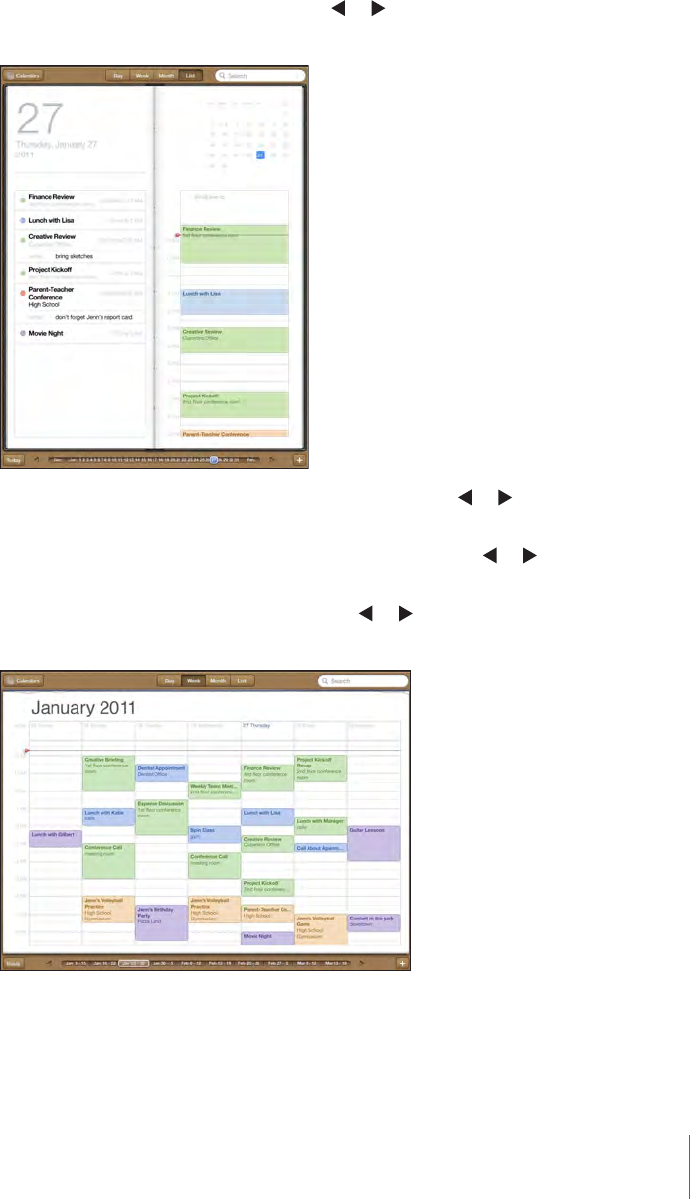
ÂList view: All your appointments and events appear in a scrollable list, next to the
selected day. To view a dierent day, tap or or select a day from the timeline
below the calendar.
ÂDay view: Scroll up or down to see the day’s events. Tap or to see the previous
or next day’s events, or select a day from the timeline below the calendar.
ÂWeek view: Scroll up or down to see the week’s events. Tap or to see the
previous or next week, or select a week from the timeline below the calendar.
ÂMonth view: Tap a day to see its events. Tap or to see the previous or next
month, or select a month from the timeline below the calendar.
See the details of an event: Tap the event.
87
Chapter 12 Calendar

See events adjusted for a time zone: In Settings, go to “Mail, Contacts, Calendars.”
Under Calendars, tap Time Zone Support. Turn on Time Zone Support and select a
major city for the time zone you want to use. When Time Zone Support is o,
iPad Wi-Fi + 3G displays events in the time zone of your current location as determined
by the cellular network time.
Searching Calendars
You can search the titles, invitees, notes, and locations of the events in your calendars.
Calendar searches just the calendar or calendars you’re currently viewing.
Search for events: Enter text in the search eld.
Search results appear as you type. Tap a result to view the event. Tap the calendar to
close the list of search results.
Subscribing to Calendars
You can subscribe to calendars that use the iCalendar (.ics) format. Many calendar-based
services, including Yahoo!, Google, and iCal on the Mac, support calendar subscriptions.
Subscribed calendars are read-only. You can read events from subscribed calendars on
iPad, but you can’t edit them or create new events.
Subscribe to a CalDAV or .ics calendar:
1 In Settings, choose “Mail, Contacts, Calendars,” then tap Add Account.
2 Choose Other, then choose Add Subscribed Calendar.
3 Enter your account information, then tap Next to verify the subscription.
4 Tap Save.
Apple provides links to a number of free iCal calendars—for national holidays or sports
events, for example—that you may want to subscribe to.
You can also subscribe to an iCal (or other .ics) calendar published on the web, by
tapping a calendar link you receive in an email message on iPad.
88 Chapter 12 Calendar

Responding to Meeting Invitations
If you have a Microsoft Exchange account on iPad with Calendars enabled, a supported
CalDAV account, or a MobileMe calendar, you can receive and respond to meeting
invitations from people in your organization.
When you receive an invitation, the meeting appears in your calendar with a dotted
line around it. The icon in the lower-right corner of the screen shows the number
of new invitations you have. To receive and respond to meeting invitations, iPad must
have an Internet connection.
Respond to an invitation in Calendar:
1 Tap a meeting invitation in the calendar, or tap to display the Event screen and
then tap an invitation.
Tap “Invitation from” to get contact information for the meeting organizer. Tap the Â
email address to send the organizer a message.
Tap Invitees to see who is invited to the meeting. Tap a name to see the attendee’s Â
contact information. Tap an email address to send a message to the attendee.
Tap Alert to set iPad to sound an alert before the meeting. Â
Tap Add Comments to add comments for the meeting organizer. Your comments Â
will also appear in the Info screen for the meeting.
Notes are made by the meeting organizer.
2 Tap Accept, Maybe, or Decline.
When you accept, tentatively accept, or decline the invitation, the organizer is sent a
response that includes any comments you add.
You can change your response later, unless you decline. Tap Add Comments to change
or add comments.
89
Chapter 12 Calendar

Importing Calendar Files from Mail
You can add events to a calendar by importing a calendar le from an email message.
You can import any standard .ics calendar le.
Import events from a calendar le: In Mail, open the message and tap the calendar
le. When the list of events appears, tap Add All, choose the calendar you want to add
the events to, and tap Done.
Alerts
Set calendar alerts: In Settings, choose General > Sounds, then turn Calendar Alerts
on. If Calendar Alerts is o when an event occurs, iPad displays a message but makes
no sound.
Sound alerts for invitations: In Settings, choose “Mail, Contacts, Calendar.” Under
Calendars, tap New Invitation Alert to turn it on.
90 Chapter 12 Calendar
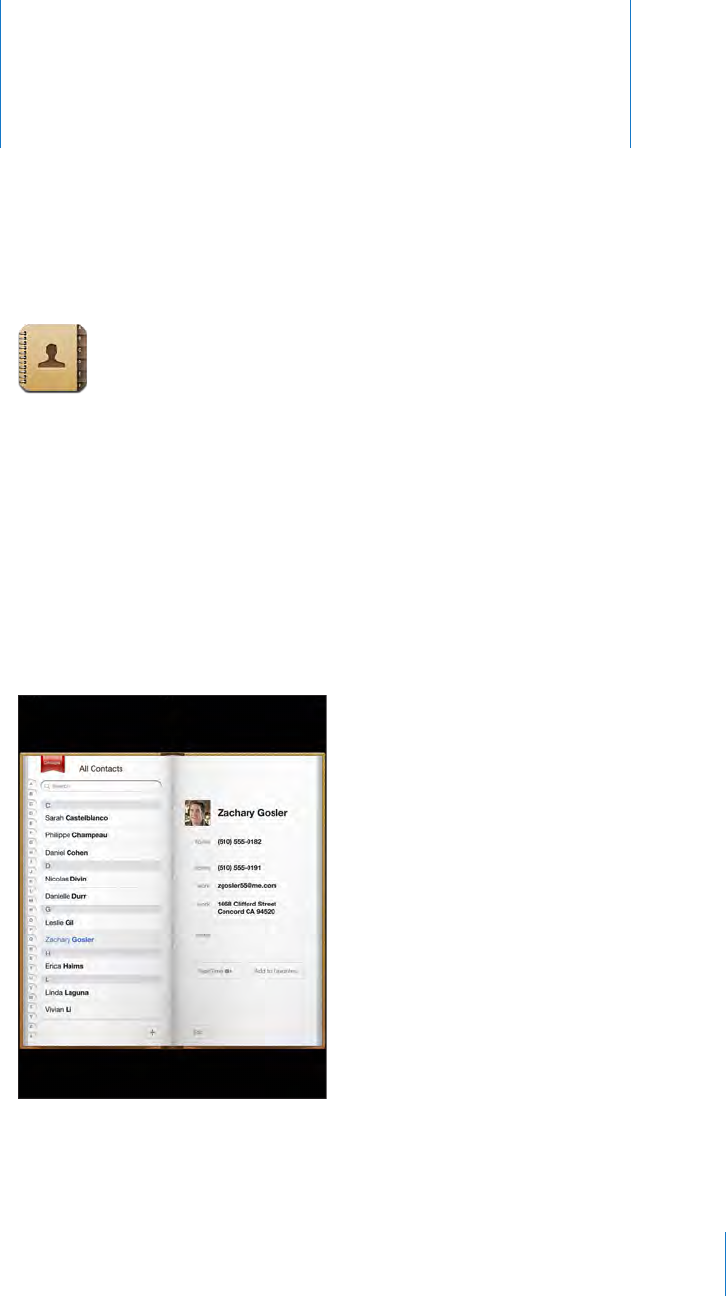
Contacts 13
About Contacts
iPad lets you easily access and edit your contact lists from personal, business, and
organizational accounts. You can search across all of your groups, and the information
in Contacts is automatically accessed to make addressing emails quick and easy.
You can add contacts directly on iPad, or sync contacts from applications on your
computer. If you have a MobileMe or Microsoft Exchange account with Contacts
enabled, or a supported CardDAV account, you can sync your contacts over the air
without connecting iPad to your computer.
91

Syncing and Adding Contacts
You can add contacts to iPad in these ways:
Enter contacts on iPad Â
In iTunes, sync contacts from Google or Yahoo!, or sync with applications on your Â
computer (see “Syncing with iTunes” on page 24)
Set up a MobileMe or Microsoft Exchange account on iPad with Contacts enabled Â
(see “Adding Mail, Contacts, and Calendar Accounts” on page 31)
Install a prole that sets up an Exchange account with Contacts enabled (see Â
“Setting Up Microsoft Exchange Accounts” on page 172 )
Set up an LDAP or CardDAV account on iPad to access business or school directories Â
(see “LDAP and CardDAV Accounts” on page 173 )
Searching Contacts
You can search rst, last, and company names in your contacts on iPad. If you have a
Microsoft Exchange account on iPad, you may also be able to search your enterprise
Global Address List (GAL) for contacts in your organization. If you have an LDAP
account on iPad, you can search contacts on your organization’s LDAP server. If you
have a CardDAV account, you can search contacts synced to iPad, or searchable
contacts on a supported CardDAV server.
When you enter search information, contacts with matching information appear as
you type.
Search contacts: In Contacts, tap the search eld at the top of the screen and enter a
rst, last, or company name. To scroll quickly to the top of the list, tap the status bar.
Search a GAL: Tap Groups, tap the Exchange server name, then enter a rst, last, or
company name.
You can’t edit GAL contacts or save them to iPad.
Search an LDAP server: Tap Groups, tap the LDAP server name, then enter a rst, last,
or company name.
You can’t edit LDAP contacts or save them to iPad.
Search a CardDAV server: Tap Groups, tap the searchable CardDAV group at the
bottom of the list, then enter your search.
You can’t edit searchable CardDAV contacts from the server, but you can edit synced
CardDAV contacts on iPad.
92 Chapter 13 Contacts

Managing Contacts
You can edit your contacts and mark as favorites the ones you use frequently
with FaceTime.
Add a contact on iPad: Tap Contacts, then tap .
Delete a contact In Contacts, choose a contact, then tap Edit.
Scroll down, then tap Delete Contact.
Add a contact to FaceTime Favorites In Contacts, choose a contact, then tap Favorites.
Edit FaceTime Favorites In FaceTime, tap Favorites, then tap Edit. To delete
an item, tap .
Edit contact information In Contacts, choose a contact, then tap Edit. To
add an item, tap . To delete an item, tap .
Assign a photo to a contact:
1 Tap Contacts, then choose a contact.
2 Tap Edit and tap Add Photo, or tap the existing photo.
3 Tap an album, then tap a photo.
4 Drag and scale the photo.
5 Tap Choose.
Using Contact Information
You can use the information on a contact’s Info screen to:
Create an email message in Mail, addressed to the contact Â
Open the contact’s home page in Safari Â
Find the location of the contact’s address in Maps, and get directions Â
Share the contact information with others Â
Call a contact using FaceTime Â
Use a contact’s info screen: Tap Contacts and choose a contact, then tap an item.
Placing a FaceTime call: Tap Contacts and choose a contact, then tap FaceTime and
choose an email address or phone number to use for the call. If you don’t see the
FaceTime button, turn on FaceTime in Settings > FaceTime.
93
Chapter 13 Contacts

Unied Contacts
When you sync contacts with multiple accounts, you might have entries for the same
person in more than one account. To keep redundant contacts from appearing in the
All Contacts list, you can link contacts that have the same rst and last name (but not
a dierent prex, sux, or middle name) and display them as a single unied contact.
When you view a unied contact, the title Unied Info appears at the bottom of the
contact’s entry. Unied contacts appear only when you view the All Contacts list.
Link contacts: Find the rst contact that you want to link, then tap Edit. Tap and
select the other contact, then tap Link.
When a contact is linked, tap the silhouette icon to view, add, or delete linked entries.
Linked contacts aren’t merged. Unless you edit a unied contact, the contact in each
source account remains separate. If you change information in a unied contact, the
changes are copied to each source account that information already exists in. If you
add information to a unied contact, that information is added to the contact in each
source account.
94 Chapter 13 Contacts
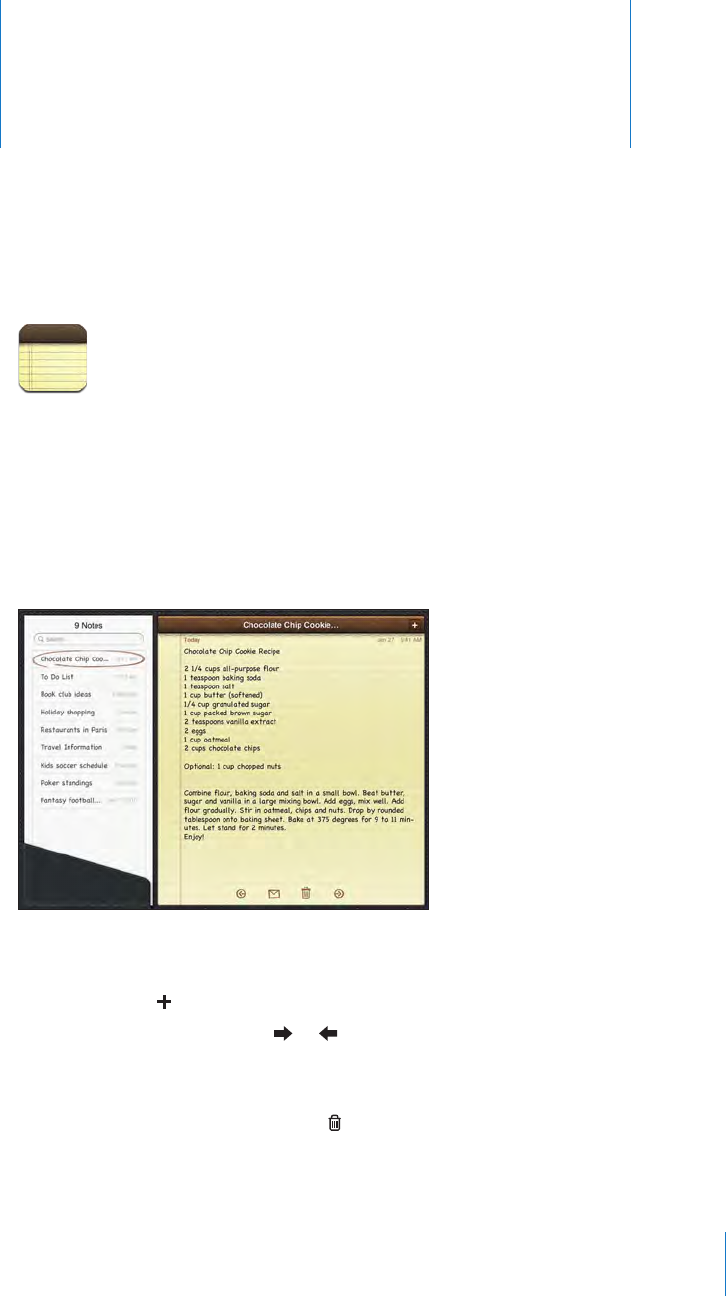
Notes 14
Writing and Reading Notes
With its large display and onscreen keyboard, iPad makes jotting notes easy.
You can view notes in landscape or portrait orientation. In portrait orientation, tap
Notes to view a list of your notes. In landscape orientation, the list of notes appears on
the left, and the current note is circled in red.
Notes are listed by last-modied date, with the most recent note at the top. The list
shows the rst few words of each note. Tap a note in the list to view or edit it.
Add a note: Tap , type the note, then tap Done.
Read a note: Tap the note. Tap or to see the next or previous note.
Edit a note: Tap anywhere on the note to bring up the keyboard. Edit the note, then
tap Done.
Delete a note: Tap the note, then tap .
Change the font used to display notes: In Settings, choose Notes and select a font
from the list.
95

Searching Notes
You can search the text of notes to nd a particular note.
Search for notes: Enter text in the search eld that appears at the top of the notes list.
(In portrait orientation, tap Notes to display the notes list.)
Search results appear automatically as you type. Tap the keyboard button to dismiss
the keyboard and see more results. To view a note, tap it in the search results list.
Emailing Notes
Email a note: Tap the note, then tap .
To email a note, iPad must be set up for email. See “Setting Up Email Accounts” on
page 53.
Syncing Notes
You can set iTunes to automatically sync your notes with some email applications.
See “Setting Up Syncing” on page 24.
You can also sync notes over the air, when iPad has an Internet connection. Go to
Settings > Notes, then select the default mail account for syncing notes. New notes
you create on iPad will be stored in the account you select. To view notes stored in a
specic account, open Notes and tap Accounts.
96 Chapter 14 Notes
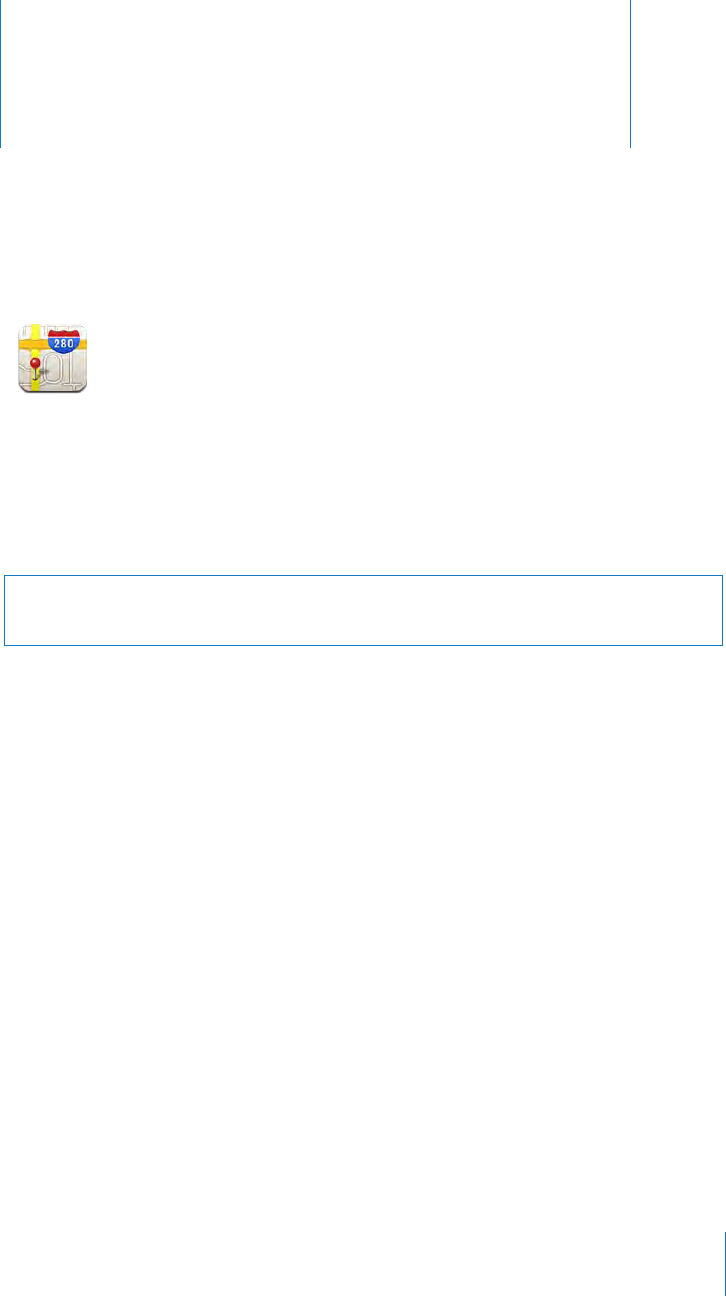
Maps 15
About Maps
Maps provides classic, satellite, hybrid, and terrain views of locations in many countries.
Search for a location, then get detailed driving, public transit, or walking directions, as
well as trac information.
WARNING: For important information about driving and navigating safely, see the
Important Product Information Guide at support.apple.com/manuals/ipad.
To use Maps, iPad must have an Internet connection. See “Connecting to the
Internet” on page 29.
Important: Maps, directions, and location-based apps provided by Apple depend
on data services provided by third parties. These data services are subject to change
and may not be available in all geographic areas, resulting in maps, directions, or
location-based information that may be unavailable, inaccurate, or incomplete.
Compare the information provided on iPad to your surroundings, and defer to posted
signs to resolve any discrepancies. To provide your location, data is collected which
doesn’t identify you personally. If you don’t want this data collected, don’t use the
feature. Not using this feature doesn’t aect the non–location-based functionality of
your iPad.
If location services is turned o when you open Maps, you may be asked to turn it
on. You can use Maps without turning on location services. See “Location Services” on
page 153.
Finding and Viewing Locations
You can search for locations, nd your current location, drop a pin to mark a location,
and get dierent map views, including Google Street Views.
97
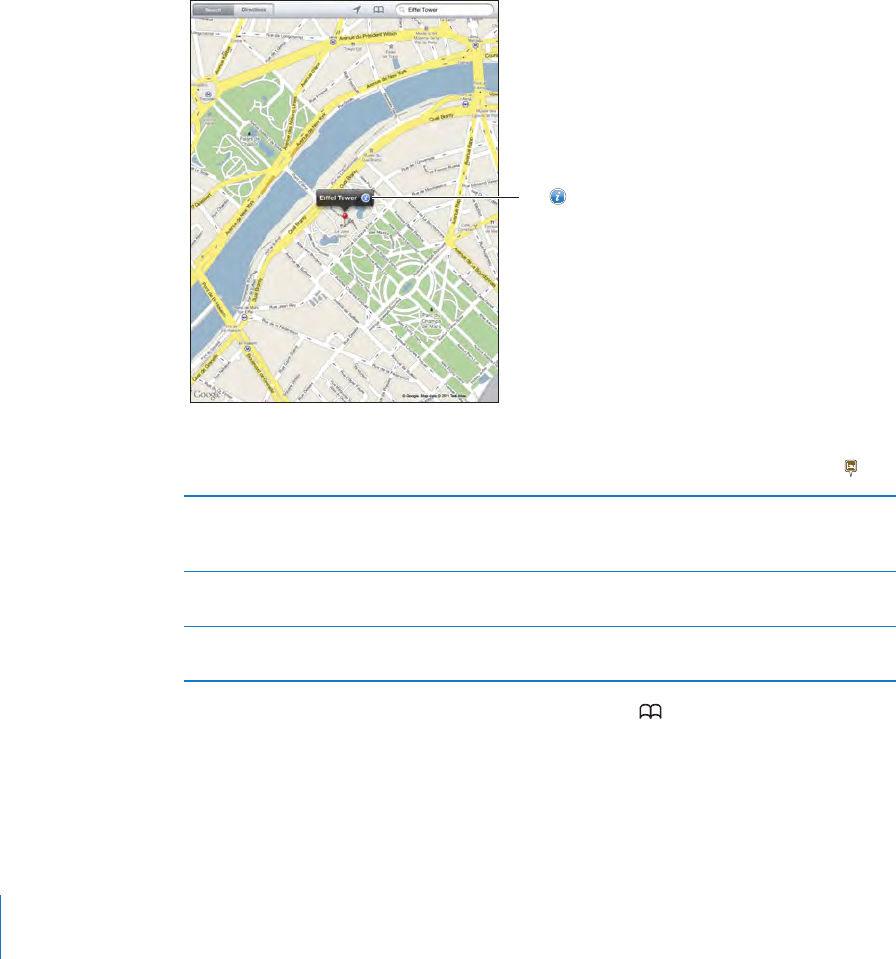
Searching for Locations
You can search for locations in many ways—by address, intersection, area, landmark,
bookmark, contact, or zip code.
Find a location and see a map:
1 Tap the search eld to bring up the keyboard.
2 Type an address or other search information.
3 Tap Search.
A pin marks the location.
Taptoget
informationabout
thelocation,get
directions,addthe
locationtoyour
bookmarksor
contactslist,or
emailalinkto
GoogleMaps.
A location can include places of interest added by Google My Maps users (“User-
created content”), and sponsored links that appear as special icons (for example, ).
Zoom in Pinch the map with two ngers. Or double-tap the part
you want to zoom in on. Double-tap again to zoom in
even closer.
Zoom out Pinch your ngers apart on the map. Or tap the map with
two ngers. Tap with two ngers again to zoom out further.
Pan or scroll Drag up, down, left, or right to view a dierent part of
the map.
See the location of an entry in your Contacts list: Tap at the top of the screen and
choose a contact.
The contact must include at least one address. If the contact has more than one address,
choose the one to locate. You can also tap an address in Contacts to nd a location.
98 Chapter 15 Maps

Finding Your Current Location
A quick tap nds your current location. The onscreen digital compass shows which
direction you’re facing.
Find your current location: Tap in the status bar at the top of the screen.
A blue marker shows your current location. If Maps can’t determine your exact
location, a blue circle appears around the marker. The size of the circle depends on
how precisely your location can be determined—the smaller the circle, the greater
the precision.
If you drag the map, then tap again, iPad centers the map back to your current
location.
Use the digital compass: Tap a second time. changes to and a small digital
compass appears onscreen. Use the digital compass to nd which direction
you’re heading.
Note: You need to calibrate the compass the rst time you use it, and you may need to
calibrate it occasionally after that.
Calibrate the compass: When the calibrate symbol appears, wave iPad in a gure
eight. You may be asked to move away from a source of interference.
See which way you’re facing: Hold iPad level to the ground. The compass rotates to
point north.
Return to map view: Tap to go back to the map view.
iPad uses Location Services to determine your location. Location Services uses
available information from local Wi-Fi networks if you have Wi-Fi turned on. This
feature isn’t available in all areas.
Your current location can’t be found if Location Services is turned o, so you may be
prompted to turn it on. See “Location Services” on page 153.
When you’re not using Location Services, you can turn it o to conserve battery power.
In Settings, choose General > Location Services.
Get information about your current location: Tap the blue marker, then tap . iPad
displays the address of your current location, if available. You can use this information to:
Get directions to or from this location Â
Add the location to contacts Â
Send the address in email Â
Bookmark the location Â
See a street view (when available) Â
99
Chapter 15 Maps
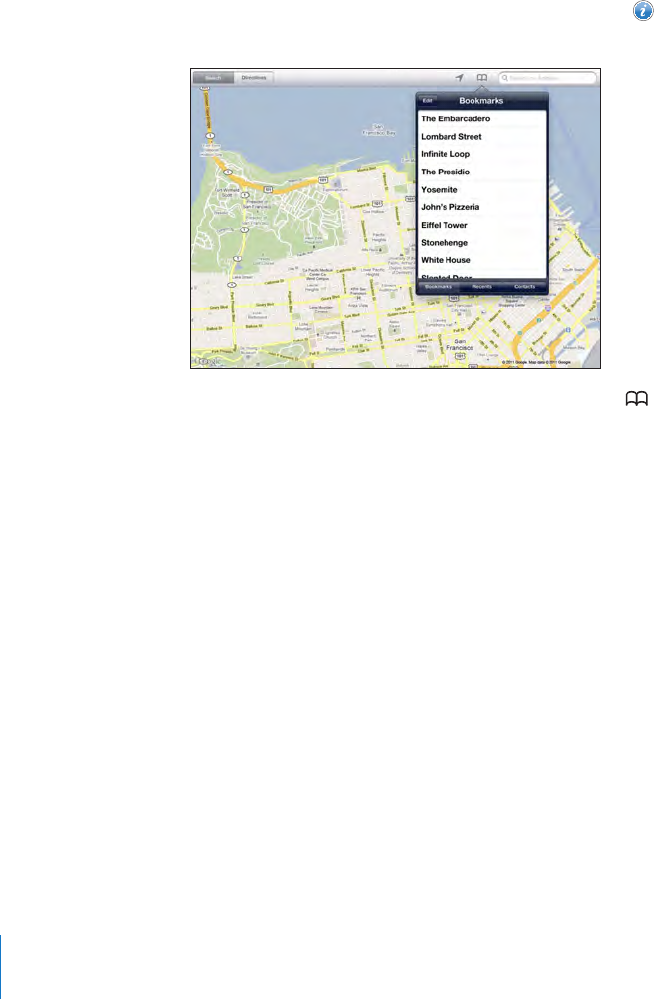
Marking a Location with a Drop Pin
A drop pin lets you mark a location by hand.
Drop a pin: Touch and hold any location on the map. Or, you can drag or tap the
lower-right corner of the screen, then tap Drop Pin.
A pin drops on the map. Touch and hold the pin, then drag it to any location you choose.
Bookmarking Locations
You can bookmark any location that you want to nd later.
Bookmark a location: Find a location, tap the pin, tap next to the name or
description, then tap “Add to Bookmarks.”
See a bookmarked or recently viewed location: Tap at the top of the screen, then
tap Bookmarks or Recents.
Clear the list of recents: Tap Clear.
Rearrange or delete a bookmark: Tap Edit.
100 Chapter 15 Maps

Map Views
You can choose classic, satellite, hybrid, or terrain view. You can also see a location in
street view, when available.
Change the view: Tap or drag the bottom-right corner of the screen, then tap Classic,
Satellite, Hybrid, or Terrain.
See a street view: Tap a drop pin, then tap . You can ick up or down, or left or
right, to pan through the 360° panoramic view. The inset in the lower-right corner
shows your current view. Tap an arrow to move down the street. Street view isn’t
available in all areas.
To return to map view, tap the inset.
Taptoreturntomapview
101
Chapter 15 Maps
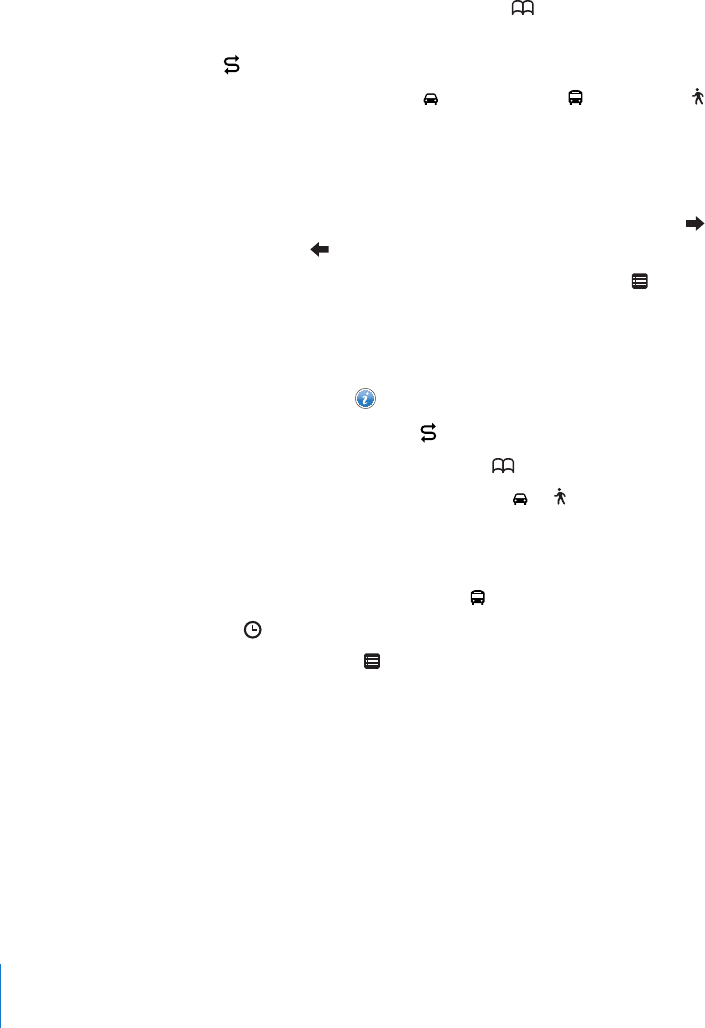
Getting Directions
You can get step-by-step driving, public transit, or walking directions.
Get directions:
1 Tap Directions.
2 Tap the elds at the top of the screen to enter your starting and ending locations.
Normally, iPad starts with your current location (if available).
If an address is in your contacts list, tap , choose the contact, and tap Directions
To Here or Directions From Here.
Tap to reverse the directions.
3 Select directions for driving ( ), public transit ( ), or walking ( ) at the bottom of
the screen.
The available travel options depend on the route.
4 Do one of the following:
ÂTo view directions one step at a time, tap Start, and then tap to see the next leg of
the trip. Tap to go back.
ÂTo view the directions in a list, tap Start, and then tap . Tap any item in the list
to see a map showing that leg of the trip. Tap Route Overview to return to the
overview screen.
You can also get directions by nding a location on the map, tapping the pin that
points to it, tapping , then tapping Directions To Here or Directions From Here.
Get reverse directions: Tap to switch the start and end points.
See recently viewed directions: Tap in the search eld, then tap Recents.
See driving or walking directions: Tap or .
If you’re driving or walking, the approximate distance and travel time appear onscreen.
If trac data is available, the driving time adjusts accordingly.
See public transit directions: Tap .
Tap  to set your departure or arrival time, and to choose a schedule for the trip.
Tap Start, then tap  to see the Route Overview screen. From there, you see the
estimated arrival time, total fare, information about each leg of the trip, and the
mode of transportation—including where you need to walk.
102 Chapter 15 Maps

Showing Trac Conditions
When available, you can show trac conditions for major streets and highways on
the map.
Show or hide trac conditions: Tap or drag the bottom-right corner of the screen,
then turn Trac on or o.
Green=posted
speedlimit
Yellow=slower
thantheposted
speedlimit
Red=stopandgo
Streets and highways are color-coded according to the ow of trac. If a street or
highway is gray, trac data isn’t available.
If you don’t see trac conditions, zoom out to see major roads. Trac conditions are
not available in all areas.
Finding and Contacting Businesses
Find businesses in an area:
1 Find a location—for example, a city or a street address—or scroll to a location on
the map.
2 Type the kind of business in the Search eld and tap Search on the keyboard.
Pins appear for matching locations in the area. For example, if you locate your city and
then type “movies” and tap Search, pins mark movie theaters in your city.
Tap the pin that marks a business to see its name or description.
Find businesses without rst nding the location: Type things like:
restaurants san francisco ca Â
apple inc new york Â
103
Chapter 15 Maps
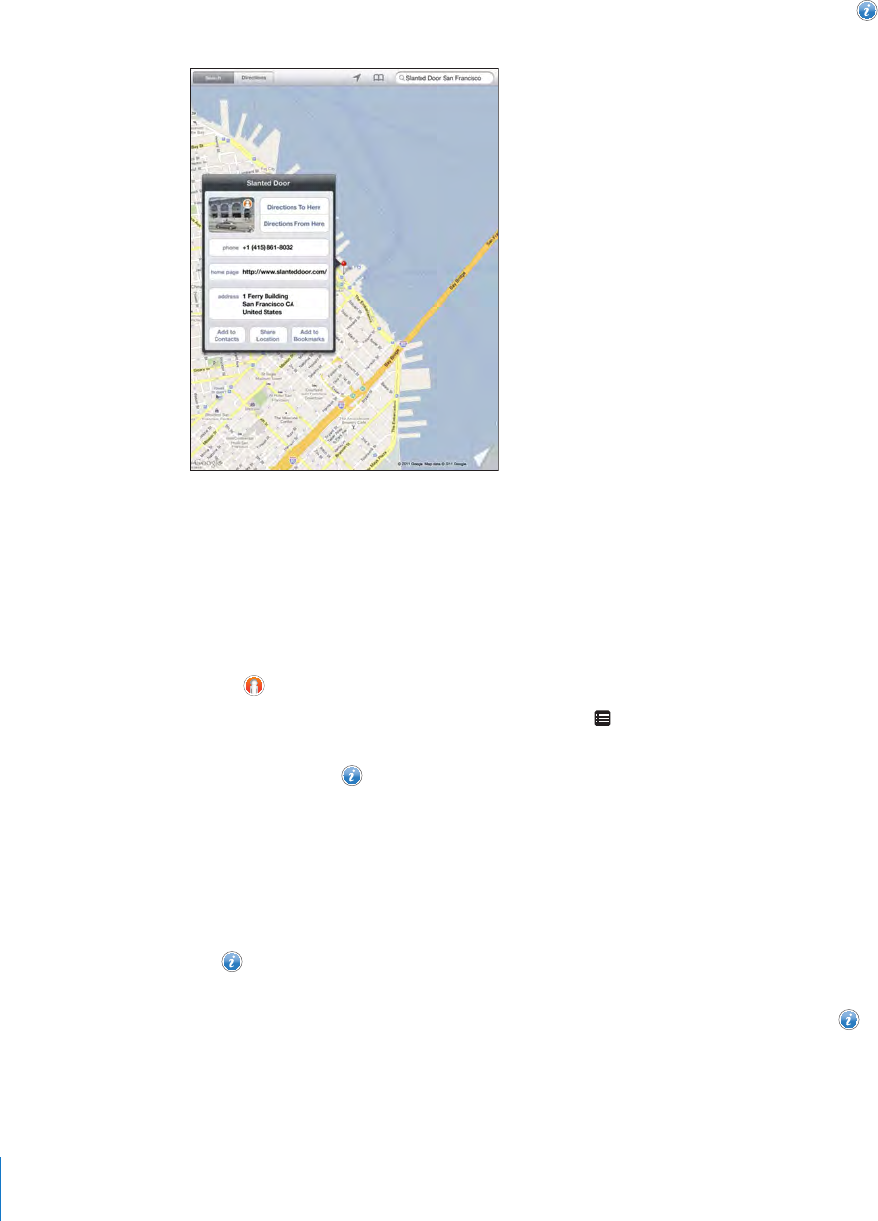
Contact a business or get directions: Tap the pin that marks a business, then tap
next to the name.
From there, you can do the following:
Tap Directions To Here or Directions From Here to nd directions. Â
Tap Home Page to visit the website, or Email to send an email. Â
Tap “Add to Contacts,” and then tap “Create New Contact” or “Add to Existing Â
Contact.”
Share the location of the business by email. Â
Tap  to see a street view.
See a list of businesses found in the search: Tap in the search eld.
Choose a business from the Results list to see its location. Tap the pin that marks a
business, then tap next to the business to see its information.
Sharing Location Information
You can add a location to your contacts. You can also send links to a map location
in email.
Add a location to your contacts list: Find a location, tap the pin that points to it,
tap next to the name or description, tap “Add to Contacts,” and then tap “Create
New Contact” or “Add to Existing Contact.”
Email a link to a map location: Find a location, tap the pin that points to it, tap ,
and then tap Share Location.
104 Chapter 15 Maps
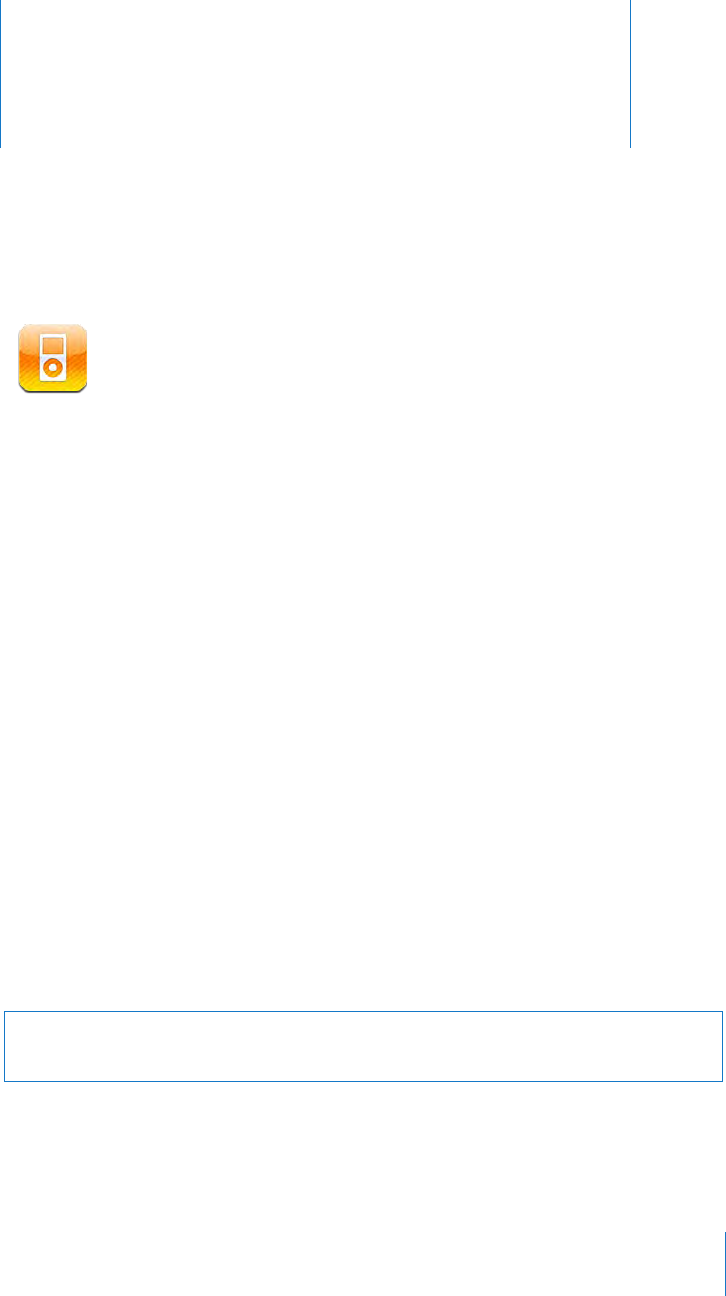
iPod 16
Adding Music and More to iPad
Browse your music collection by song, artist, album, genre, or composer. Listen to your
songs, audiobooks, and podcasts. Create and manage playlists, or use Genius to create
playlists for you. Stream your music, podcasts, or audiobooks wirelessly to an Apple TV
using AirPlay.
There are two ways to get music and other content onto iPad:
Transfer content by syncing it from iTunes on your computer. You can sync all of Â
your music, or you can select specic songs, podcasts, and iTunes U collections. See
“Syncing with iTunes” on page 24.
Use the iTunes Store on iPad to purchase and download songs, albums, TV shows, Â
movies, music videos, and audiobooks. You can also stream and download audio
and video podcasts, as well as iTunes U content. After listening to a podcast or
watching a TV show, you can tap a link to get more episodes from the iTunes Store.
See Chapter 17, “ iTunes Store,” on page 113 .
Playing Music and Other Audio
Listen to audio using the built-in speaker. You can also attach wired headphones to the
headphones port, or pair wireless Bluetooth headphones. Sound doesn’t come out of
the speaker when you attach or pair headphones.
WARNING: For important information about avoiding hearing loss, see the
iPad Important Product Information Guide at support.apple.com/manuals/ipad.
Playing Songs
Browse your collection: Tap Music, Podcasts, Audiobooks, iTunes U, or Purchased. At
the bottom of the screen, tap Songs, Artists, Albums, Genres, or Composers to browse.
105
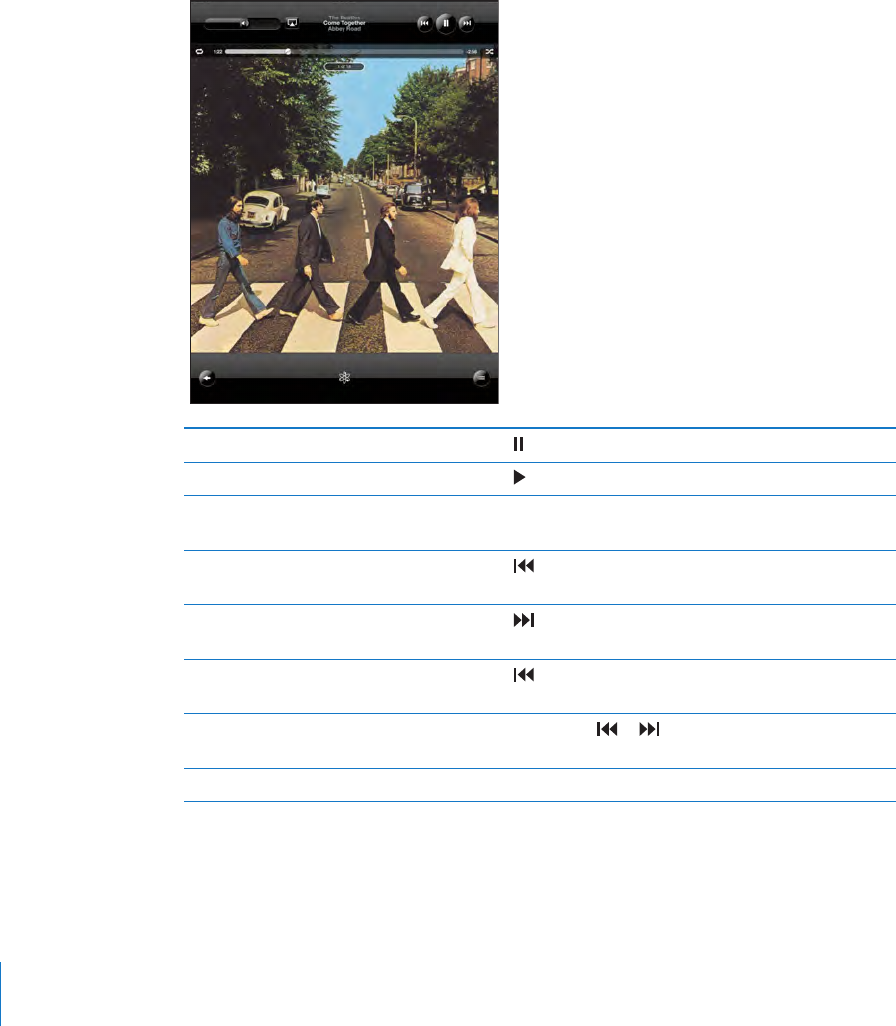
Browse Genius playlists or Genius Mixes: Tap Genius or Genius Mixes. If Genius
doesn’t appear, you may need to turn on Genius in iTunes, then sync iPad. See “Making
Genius Playlists” on page 110 .
Play a song: Tap the song.
Controlling Song Playback
When you play a song, the Now Playing screen appears.
Pause a song Tap .
Resume playback Tap .
Raise or lower the volume Drag the onscreen volume slider or use the iPad
volume buttons.
Restart a song or a chapter in an
audiobook or podcast
Tap .
Skip to the next song or chapter in
an audiobook or podcast
Tap .
Go to the previous song or chapter
in an audiobook or podcast
Tap twice.
Rewind or fast-forward Touch and hold or —the longer you hold the
control, the faster the song rewinds or fast-forwards.
View album art full-size Tap the album cover when playing a song.
You can display playback controls when you’re listening to music and using another
app—or even when iPad is locked.
106 Chapter 16 iPod
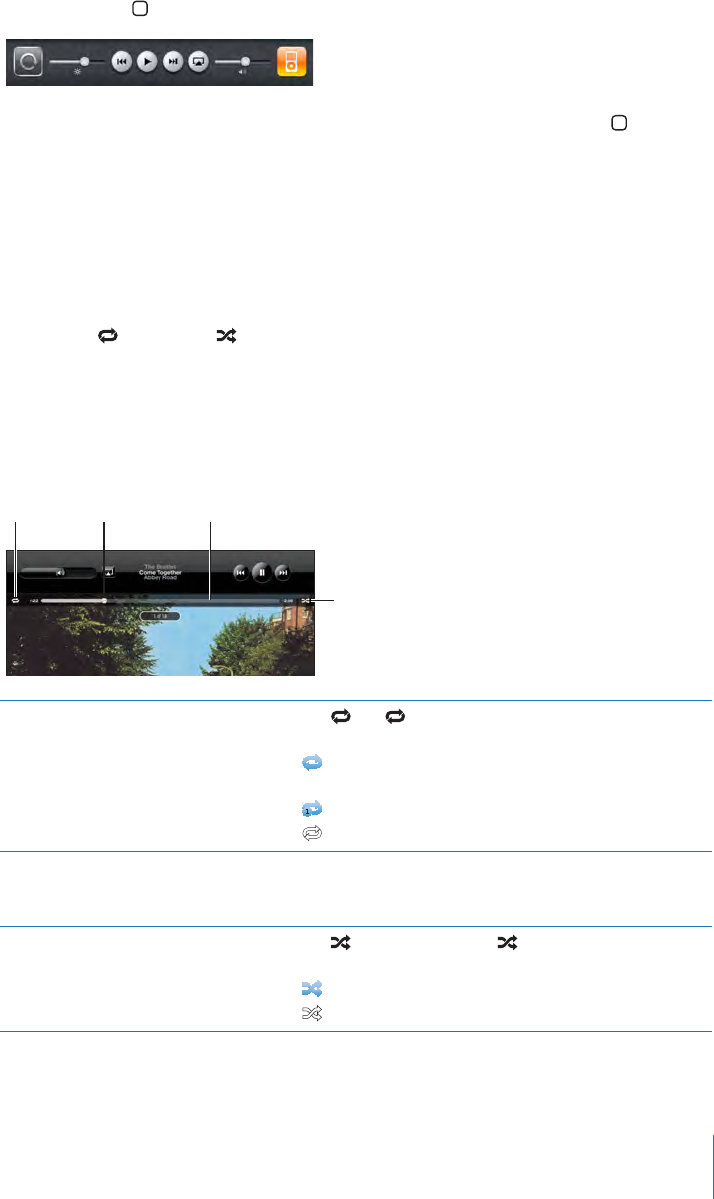
Display audio playback controls from another app or from the Lock screen: Double-
click the Home button, then ick from left to right along the bottom of the screen.
After using the controls, tap iPod to go your iPod library or click the Home button to
return to the app you were using.
If iPad is locked, the controls appear at the top of the screen and then disappear after
you nish using them.
Additional Song Controls
From the Now Playing screen, tap the album cover to see the controls.
The repeat and shue controls appear along with the scrubber bar. You can see
elapsed time, remaining time, and the song number.
Drag the playhead along the scrubber bar to skip to any point in the song. You can
adjust the scrub rate from high-speed to ne by sliding your nger down as you drag
the playhead along the scrubber bar. The scrub rate becomes slower the farther down
you slide your nger.
Repeat Playhead Scrubberbar
Shuffle
Set iPad to repeat songs Tap . Tap again to set iPad to repeat only the
current song.
= iPad is set to repeat all songs in the current album
or list.
= iPad is set to repeat the current song over and over.
= iPad isn’t set to repeat songs.
Skip to any point in a song Drag the playhead along the scrubber bar. Slide your
nger down to adjust the scrub rate. The scrub rate
becomes slower the farther down you slide your nger.
Set iPad to shue songs Tap to shue songs. Tap again to set iPad to play
songs in order.
= iPad is set to shue songs.
= iPad is set to play songs in order.
107
Chapter 16 iPod
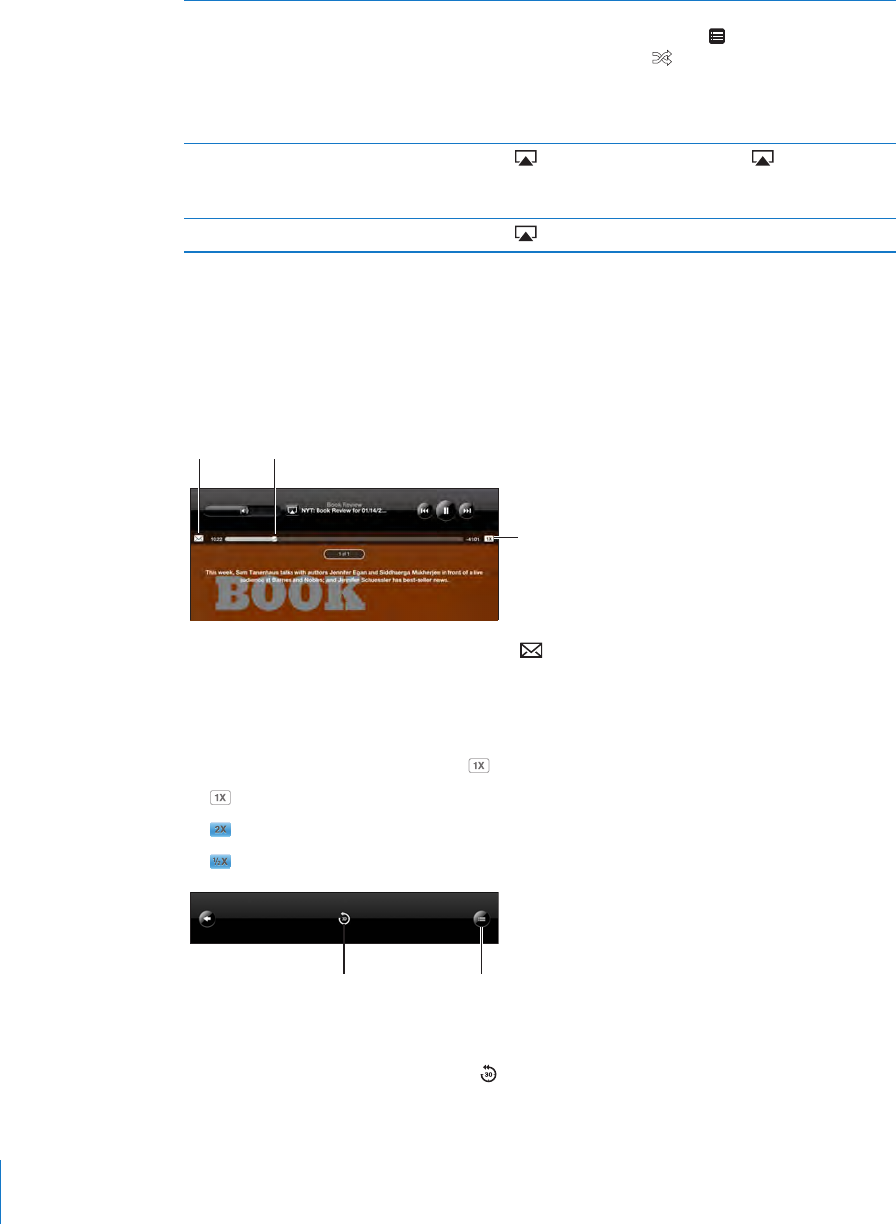
Shue the tracks in any playlist,
album, or other list of songs
From the Now Playing screen, tap the album art to show
the song controls onscreen. Tap at the bottom of the
screen, then tap Shue at the top of the list of songs.
Whether or not iPad is set to shue, if you tap Shue at
the top of a list of songs, iPad plays the songs from that
list in random order.
Play music on an AirPlay sound system
or Apple TV
Tap and choose a sound system. If doesn’t appear
or if you don’t see the AirPlay system you’re looking for,
make sure it’s on the same wireless network.
Switch from AirPlay back to iPad Tap and choose iPad from the list.
Podcast and Audiobook Controls
From the Now Playing screen, tap the podcast or audiobook cover to see the controls.
The email control and playback speed control appear along with the scrubber bar.
You can see elapsed time, remaining time, and the episode or chapter number. The
scrubber bar lets you skip to any point in the podcast or audiobook.
Email Playhead
Playback
speed
Send an email link to this podcast: Tap .
Skip to any point: Drag the playhead along the scrubber bar. Adjust the scrub rate
from high-speed to ne by sliding your nger down as you drag the playhead along
the scrubber bar. The scrub rate becomes slower the farther down you slide your nger.
Change the playback speed: Tap to change the speed.
 = Play at normal speed
 = Play at double speed
 = Play at half speed
Tracklist
30-second
repeat
The 30-second repeat control and track list control appear at the bottom of the screen.
Play back the last 30 seconds: Tap .
108 Chapter 16 iPod

See other podcasts in a series or chapters in an audiobook: Tap . Tap the podcast or
audiobook thumbnail to return to the Now Playing screen.
Viewing All Tracks on an Album
See all the tracks on the album that contains the current song: On the Now Playing
screen, tap . Tap a track to play it. Tap the album thumbnail to return to the Now
Playing screen.
In track list view, you can assign ratings to songs. You can use ratings to create smart
playlists in iTunes that dynamically update to include, for example, your highest
rated songs.
Rate a song: Drag your thumb across the rating bar (the ve dots under the playhead)
to give the song zero to ve stars.
Searching Music
You can search the titles, artists, albums, and composers of songs, podcasts, and other
content you’ve synced to iPad.
Search music, podcasts, audiobooks, or other content in your library: Enter text in the
search eld at the top of a song list, playlist, artist list, or other view of your iPod content.
(Tap the status bar to scroll quickly to the top of a list and reveal the search eld.)
Search results appear automatically as you type. Tap Search to dismiss the keyboard
and see more of the results.
You can also use Spotlight to search for music. See “Spotlight Search” on page 157.
Using Playlists
A playlist is a custom compilation of songs. You might want to create a playlist for a
specic mood or occasion or organize your music library. You can use three kinds of
playlists on iPad—standard playlists, Genius playlists, and Genius Mixes.
Creating Playlists
You can make playlists from the music, podcasts, or audiobooks in your iPod library.
Make a standard playlist:
1 Tap iPod, then tap at the bottom of the screen.
2 Enter a name for the playlist, then tap Save.
3 Tap next to your selections, then tap Done when you nish selecting. You can also
tap Sources to browse for selections.
4 When you nish, tap Done.
109
Chapter 16 iPod
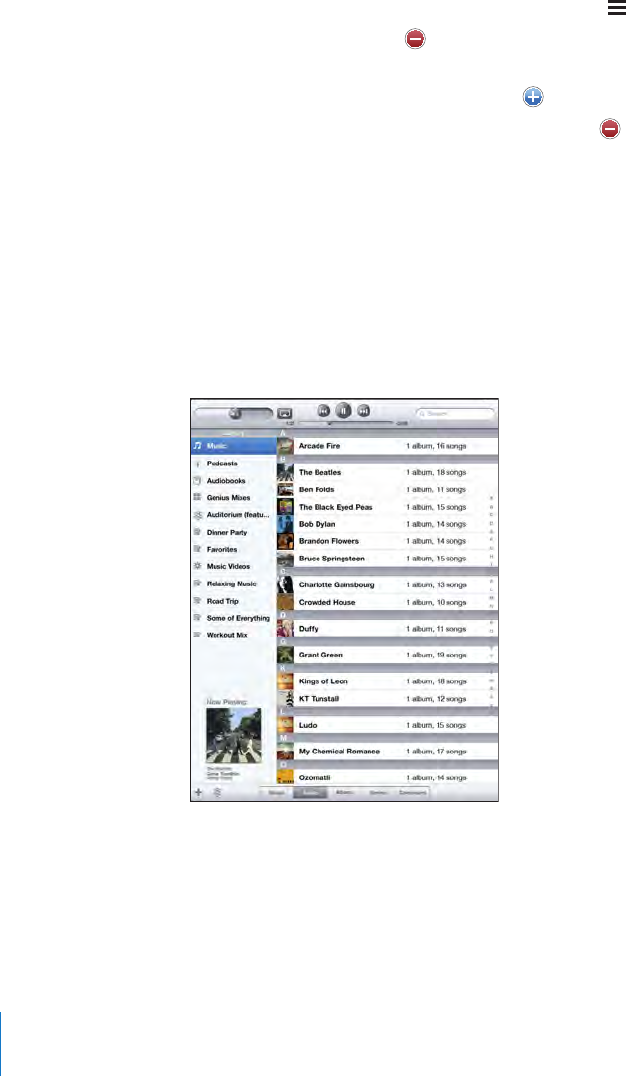
You can also make playlists from other categories in your iPod library, such as podcasts
or audiobooks.
When you make a playlist on iPad, the playlist is also saved in the iTunes library on
your computer the next time you sync.
Edit a playlist: Tap the playlist, tap Edit, then do one of the following:
ÂTo move a selection higher or lower in the list, drag next to the selection.
ÂTo delete a selection, tap next to the selection, then tap Delete. Deleting a song
from a playlist doesn’t delete it from iPad.
ÂTo add more songs, tap Add Songs, tap next to the selection, then tap Done.
Clear a playlist: Tap the playlist, tap Edit, then tap .
Making Genius Playlists
Genius nds songs in your iTunes library that go great together. A Genius playlist is a
collection of songs that are picked for you to go with a song you choose from your library.
You can create Genius playlists in iTunes and sync them to iPad. You can also create
and save Genius playlists on iPad.
To use Genius on iPad, rst turn on Genius in iTunes, then sync iPad with iTunes.
Genius is a free service, but requires an Apple ID.
110 Chapter 16 iPod

Make a Genius playlist on iPad:
1 Tap , then tap New.
2 Tap a song in the list. Genius creates a playlist of similar songs.
You can also make a Genius playlist of songs that go great with the song you’re
playing. From the Now Playing screen, tap the album cover to display additional
controls, then tap .
Save a Genius playlist: In the playlist, tap Save. The playlist is saved in Genius with the
title of the song you picked.
You can make and save as many Genius playlists as you want. If you save a Genius
playlist created on iPad, it syncs back to iTunes the next time you connect.
Refresh a Genius playlist: In the playlist, tap Refresh.
Refreshing a Genius playlist creates a Genius playlist of dierent songs that go great
with the song you picked. You can refresh any Genius playlist, whether it was created
in iTunes and synced to iPad, or created on iPad.
Create a Genius playlist from a new song: In the playlist, tap New, then pick a new song.
Delete a saved Genius playlist: Tap the Genius playlist, then tap Delete.
Once a Genius playlist is synced back to iTunes, you won’t be able to delete it directly
from iPad. You can use iTunes to edit the playlist name, stop syncing, or delete the playlist.
Playing Genius Mixes
Genius automatically searches your iPad library and nds songs from your library in
that genre or format. Genius Mixes are recreated each time you listen to them, so
they’re always new and fresh.
Genius Mixes creates dierent mixes depending on the variety of music you have in
your iPad library. For example, you may have Genius Mixes that highlight Classical,
Jazz, or Alternative Rock songs.
Browse Genius Mixes: On the left side of the iPod window (below Genius), tap
Genius Mixes.
Play a Genius Mix: Tap the mix.
111
Chapter 16 iPod

Home Sharing
Home Sharing lets you play music, movies, and TV shows on iPad from the iTunes
library on your Mac or PC.
Note: Booklets, albums, LPs, and other bonus content can’t be shared.
iPad and your computer must be on the same Wi-Fi network. iTunes on your computer
must be open, with Home Sharing turned on and logged in to the same Apple
account as Home Sharing on iPad.
Turn on Home Sharing in iTunes: On your computer, open iTunes and choose
Advanced > Turn On Home Sharing. Enter your Apple ID and password, then click
Create Home Share.
Play music or video on iPad from your iTunes library:
1 In Settings, choose iPod then, under Home Sharing, enter the same Apple ID and
password you used when turning on Home Sharing in iTunes.
2 In iPod, tap More, then tap Shared and choose your iTunes library.
The Playlists, Artists, Songs, and other tabs in iPod now show the content of your
iTunes library, instead of your iPad content.
Return to the content on your iPad: In iPod, tap More, then tap Shared and choose
iPad at the top of the list.
Transferring Content
You can transfer purchases you make on iPad to a computer that’s authorized to play
content from your Apple ID. To authorize the computer, open iTunes on the computer
and choose Store > Authorize This Computer.
Transfer purchased content: Connect iPad to your computer. iTunes asks if you want
to transfer purchased content.
112 Chapter 16 iPod

iTunes Store 17
About the iTunes Store
Use the iTunes Store to add content to your iPad. You can browse and purchase
music and TV shows, buy and rent movies, or download and play podcasts or
iTunes U collections.
Many movies and TV shows are available in both standard and high denition. To
access the iTunes Store, iPad must have an Internet connection. See “Connecting to the
Internet” on page 29.
Note: The iTunes Store is not available in all regions, and iTunes Store content may
vary across regions.
Transferring Content
You can transfer purchases you make on iPad to a computer authorized to play
content from your Apple ID.
Authorize a computer: Open iTunes on the computer, then choose Store >
Authorize Computer.
Transfer purchased content: Connect iPad to your computer. iTunes veries that
you want to transfer purchased content.
113

Finding Music, Videos, and More
Browse content: At the top of the screen, browse by Genres, Featured, Top Charts,
or Genius. At the bottom of the screen, tap Music, Movies, TV Shows, Podcasts,
Audiobooks, iTunes U, or Downloads.
Search for content: Tap the search eld at the top of the screen, then use the
onscreen keyboard to enter one or more words. Tap Search on the keyboard. Search
results are grouped by category, such as Movies, Albums, or Podcasts.
Tap an item to see more information. You can read reviews, write your own review,
or email a link about the item to a friend. Depending on the item, you can also buy,
download, or rent it.
Following Artists and Friends
Use iTunes Ping to connect with the world’s music fans. Follow favorite artists to learn
about new releases and upcoming concerts and tours, get an insider’s perspective
through their photos and videos, and learn about their musical inuences. Read
friends’ comments about the music they’re listening to, and see what they’re buying
and which concerts they plan to attend. Express your musical likes and post comments
for your own followers.
To create and explore musical connections, you need to create a prole.
Create your iTunes Ping prole: Open the iTunes application on your Mac or PC,
click Ping, and follow the onscreen instructions.
114 Chapter 17 iTunes Store

Explore iTunes Ping on your iPad: Open the iTunes app, tap Ping (tap More rst,
if Ping isn’t visible), and then:
Tap Activity to see the latest from the people you follow. Updates include purchases, Â
reviews, likes, comments, and posts.
Tap People to see who you’re following and who’s following you, and to search for Â
artists or friends.
Tap My Prole to review your prole information. Â
Follow an artist: Tap Follow on the artist’s prole page.
ÂBy searching: Tap People, enter the artist’s name in the search eld at the top of the
page, then tap Search. Tap the artist’s name in the list of results, then tap Follow.
ÂWhile browsing: Tap Prole at the bottom of any album page, then tap Follow.
Follow a friend: Choose your starting group of friends when you set up your prole
using iTunes on your Mac or PC. After that, you can follow friends using Ping on iPad.
ÂBy searching: Tap People, enter your friend’s name in the search eld, then tap
Search. Tap your friend’s name in the list of matches, then tap Follow.
ÂWhile exploring Ping: Tap a person’s name, then tap Follow.
When you follow someone, they don’t automatically follow you. In your prole you can
choose to approve or decline follow requests as they arrive, or simply accept all new
followers without review.
Share your thoughts: As you browse albums and songs, tap Post to comment on a
piece of music, or tap Like just to say you like it. Your friends will see your thoughts in
their iTunes Ping Activity feed.
Share concert plans: Tap Concerts on your prole page to see upcoming
performances by the artists you follow, and to see which of your friends are going to a
show. Tap Tickets to buy your own ticket, or tap I’m Going to let others know you’ll be
there too. (Not available in all countries or regions.)
Purchasing Music or Audiobooks
When you nd a song, album, or audiobook you like in the iTunes Store, you can
purchase and download it to iPad. You can also preview it to make sure it’s what you
want.
To make purchases or write reviews, you need an Apple ID. iPad gets your account
settings from iTunes when you sync. If you don’t have an Apple ID, or if you want to
make purchases from a dierent Apple ID, go to Settings > Store.
You don’t need an Apple ID to play or download podcasts or iTunes U classes.
Preview a song: Tap the number in the column, then tap .
Preview an audiobook: Tap the item.
115
Chapter 17 iTunes Store

Purchase and download a song, album, or audiobook:
1 Tap the price and tap Buy.
2 Sign in using your Apple ID if requested, then tap OK.
If you don’t have an Apple ID, tap Create New Apple ID to set one up.
Purchases are charged to your Apple ID. If you make additional purchases within
fteen minutes, you don’t have to enter your password again.
An alert appears if you previously purchased one or more songs from an album.
Tap Buy if you want to purchase the entire album including the songs you already
purchased, or tap Cancel if you want to purchase any remaining songs individually.
Once you purchase an item, it begins downloading. See “Checking Download Status” on
page 117.
Purchased songs are added to the Purchased playlist on iPad (iPod > Purchased). If you
delete the Purchased playlist, iTunes creates a new one when you buy an item from
the iTunes Store.
You can use iTunes Store gift cards, gift certicates, or other promotional codes to
make purchases. When you sign in to your account, your remaining store credit
appears with your account information at the bottom of most iTunes Store screens.
Enter a redemption code: Tap Music, scroll to the bottom of the screen, tap Redeem,
and follow the onscreen instructions.
Purchasing or Renting Videos
When you nd a movie, TV show, or music video you like in the iTunes Store, you can
purchase and download it to iPad. You can purchase movies and TV shows in standard
(480p) or high denition (720p) format. If you purchase a high denition version, you
also receive the standard denition version.
Preview a video: Tap Preview.
Purchase or rent a video:
1 Tap Buy or Rent.
2 Sign in using your Apple ID if requested, then tap OK.
If you don’t have an Apple ID, tap Create New Apple ID to set one up.
Your purchase is charged to your Apple ID. For additional purchases made within the
next fteen minutes, you don’t have to enter your password again.
Once you purchase an item it begins downloading. Rented movies won’t begin playing
until the download completes. See “Checking Download Status” on page 117.
Purchased videos are added to the Purchased playlist on iPad (iPod > Purchased). If
you delete the Purchased playlist, iTunes creates a new one the next time you buy an
item from the iTunes Store. Purchased videos also appear in the Video app.
116 Chapter 17 iTunes Store

You can use iTunes Store gift cards, gift certicates, or other promotional codes to make
purchases. When you’re signed in using your Apple ID, your remaining store credit
appears with your account information at the bottom of most iTunes Store screens.
Enter a redemption code: Tap Music, then tap Redeem at the bottom of the screen
and follow the onscreen instructions.
Listening to or Watching Podcasts
You can listen to audio podcasts or watch video podcasts on iPad. You can also
download podcasts to iPad, and sync them to the iTunes library on your computer
when you connect.
Tap Podcasts at the bottom of the iTunes Store screen. Browse by Featured or Top
Charts. To see a list of episodes, tap a podcast. The icon indicates video podcasts.
Listen to a podcast: Tap the podcast title.
Download a podcast: Tap the Free button, then tap Get Episode. Downloaded
podcasts appear in the Podcasts list in iPod.
Listen to or watch a podcast you downloaded: In iPod, tap Podcasts, then tap the
podcast. Video podcasts also appear in the Video app.
Get more episodes of the podcast you downloaded: In the Podcasts list in iPod,
tap the podcast, then tap Get More Episodes.
Delete a podcast: In the Podcasts list in iPod, swipe left or right on the podcast, then
tap Delete.
Checking Download Status
You can check the Downloads screen to see the status of in-progress and scheduled
downloads, including purchases you’ve pre-ordered.
See the status of items being downloaded: Tap Downloads.
To pause a download, tap .
If a download is paused or interrupted, iPad starts the download again the next time
it connects to the Internet. Or, if you open iTunes on your computer, iTunes completes
the download to your iTunes library (if your computer has an Internet connection and
is signed in using the same Apple ID).
See the status of pre-ordered items: Tap Downloads.
Pre-ordered items appear in a list until the date the item is released. Tap the item for
release date information. Once the item is available for download, a download icon
appears next to the download.
Download a pre-ordered item: Tap the item, then tap .
117
Chapter 17 iTunes Store

Pre-ordered items aren’t downloaded automatically when they’re released. Return to
the Downloads screen to begin the download.
Some albums include bonus content, which is downloaded to your iTunes library on
your computer. Not all bonus content is downloaded directly to iPad.
Download bonus content: Sign in using your Apple ID. In iTunes, choose Store >
“Check for Available Downloads,” then click Check.
Syncing Content
iTunes automatically syncs everything you download or purchase on iPad to your
iTunes library when you connect iPad to your computer. This lets you access the
downloads on your computer and provides a backup if you delete purchased content
from iPad.
Purchased content is synced to the “Purchased on <name of your iPad>” playlist.
iTunes creates the playlist if it doesn’t exist. iTunes also syncs your purchases to the
Purchased playlist that iTunes uses for purchases you make on your computer, if that
playlist exists and is set to sync with iPad.
Podcasts you download sync to the Podcast list in your iTunes library.
Viewing Apple ID Information
To view iTunes Store information for your Apple ID on iPad, scroll to the bottom of the
screen and tap Sign In. If you’re already signed in, tap Account. Or, go to Settings >
Store and tap View Apple ID. You must be signed in to view your account information.
Verifying Purchases
You can use iTunes on your computer to verify that all the music, videos, apps, and
other items you bought from the iTunes Store or App Store are in your iTunes library.
You might want to do this if a download was interrupted.
Verify your purchases:
1 Make sure your computer has an Internet connection.
2 In iTunes, choose Store > Check for Available Downloads.
3 Enter your Apple ID and password, then click Check.
Purchases not yet on your computer are downloaded.
The Purchased playlist displays your purchases. However, because you can add or
remove items in this list, it might not be accurate. To see all of your purchases, sign in
to your account, choose Store > View My Account, then click Purchase History.
118 Chapter 17 iTunes Store
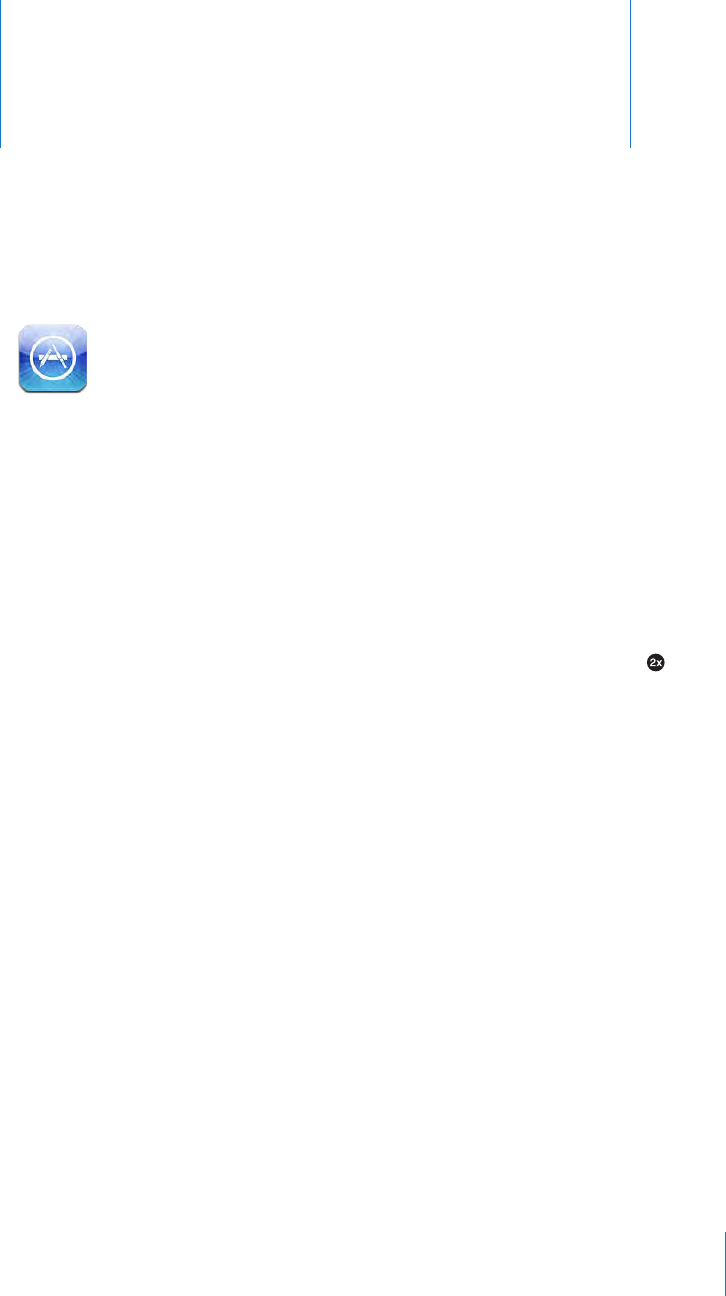
App Store 18
About the App Store
Use the App Store to add apps to iPad. Browse, purchase, and download apps
specically designed for iPad, or for iPhone and iPod touch.
Apps you download from the App Store and install on iPad are backed up to your
iTunes library the next time you sync. When you sync, you can also install apps on iPad
that you purchase through iTunes on your computer. iPad works with most iPhone and
iPod touch apps, so if you already have apps for your iPhone or iPod touch, you can
sync them to iPad from your Mac or PC. Use them at their original size, or tap in the
lower-right corner of the screen to expand them.
Note: The App Store and some apps are not available in all areas. App availability and
pricing are subject to change.
To use the App Store, iPad must have an Internet connection. See “Connecting to the
Internet” on page 29. You also need an Apple ID (not available in some countries) to
download apps. iPad gets your Apple ID settings from iTunes. If you don’t have an
Apple ID, or if you want to make purchases using a dierent Apple ID, go to Settings >
Store. See “Store” on page 170.
119
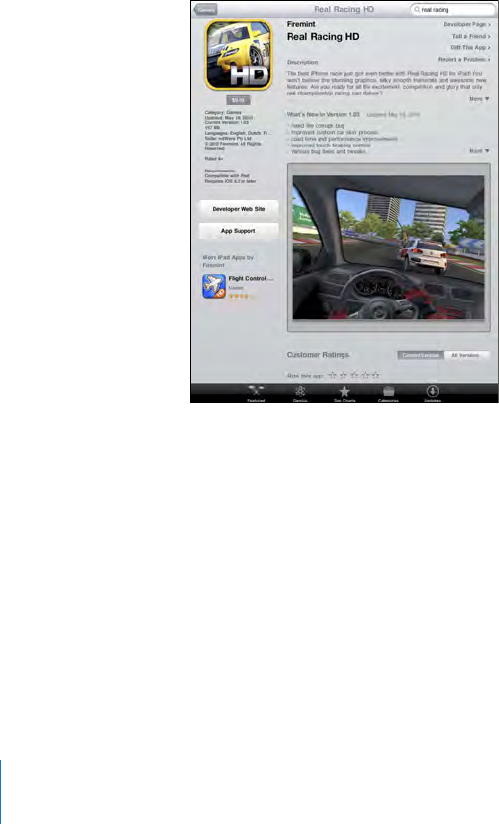
Browsing and Searching
Browse Featured to see new, notable, or recommended apps, or browse Top Charts to
see the most popular applications. If you’re looking for a specic app, use Search.
Browse apps: Tap Featured, Top Charts, or Categories at the bottom of the screen.
Browse using Genius: Tap Genius to see a list of recommended apps, based on what’s
already in your app collection. To turn Genius on, follow the onscreen instructions.
Genius is a free service, but it requires an Apple ID.
Search for apps: Tap the search eld at the top of the screen and enter one or more
words. Choose from the list of suggestions, or tap Search on the keyboard.
Getting More Information
Tap any app in a list to see the Info screen, which shows the app’s price, screenshots,
and ratings.
Email a link to the app’s Info page: Tap “Tell a Friend” at the top of the screen.
Report a problem: Tap “Report a Problem” at the top of the Info screen. Select a
problem from the list or type your comments, then tap Report.
View screenshots: Scroll down to the screenshots, then ick left or right to see
additional screenshots.
Get ratings and read reviews: Scroll down to “Customer Ratings and Reviews.”
120 Chapter 18 App Store

Buying Apps
When you nd an app you want in the App Store, you can purchase and download it
to iPad. If the app is free, you can download it without charge.
Once you download an app, it’s immediately installed on iPad.
Purchase and download an app:
1 Tap the price, then tap Buy App (or tap Free, then tap Install App).
2 Sign in using your Apple ID if requested, then tap OK.
If you don’t have an Apple ID, tap Create New Apple ID to set one up.
Purchases are charged to your Apple ID. If you make additional purchases within
fteen minutes, you don’t have to enter your password again.
You can use iTunes Store gift cards, gift certicates, or other promotional codes to
make purchases. When you sign in using your Apple ID, your remaining store credit
appears with your account information at the bottom of most App Store screens.
Enter a redemption code: Tap Featured or Top Charts, scroll to the bottom of the
screen, tap Redeem, then follow the onscreen instructions.
See the status of app downloads: After you begin downloading an app, its icon
appears on the Home screen with a progress indicator.
If a download is interrupted, iPad starts the download again the next time it connects
to the Internet. Or, if you open iTunes on your computer, iTunes completes the
download to your iTunes library (if your computer is connected to the Internet and
signed in using the same Apple ID).
Using Apps
Apps designed for iPad work in any orientation—portrait or landscape. When you use
an app in landscape orientation, it lls the screen.
On iPad, you can use apps designed for iPhone or iPod touch at their original size,
or expand them.
Expand an app: Tap in the lower-right corner.
Return an app to its original size: Tap in the lower-right corner.
Some apps let you make purchases within the app. You can restrict in-app purchases
in Settings. See “Restrictions” on page 15 8 .
121
Chapter 18 App Store

Some apps use push notications to alert you of new information, even when the
app isn’t running. Notications vary by app, but may include text or sound alerts, or a
number on the app icon on the Home screen.
Updating Apps
The App Store checks for updates to apps you install. The App Store icon shows the
total number of app updates available.
If an update is available when you access the App Store, the Updates screen appears
immediately. App updates are downloaded and installed when you choose to
update them.
Note: App upgrades are new releases, which you can purchase or download.
Update an app:
1 At the bottom of the screen, tap Updates.
2 Tap an app to see more information about the update.
3 Tap Update.
Update all apps: At the bottom of the screen, tap Updates, then tap Update All.
If you try to update an app purchased with a dierent Apple ID, you’re prompted for
that Apple ID and password.
Writing Reviews
You can write and submit app reviews on iPad.
Write a review:
1 On the Info screen, scroll down to “Customer Ratings and Reviews.”
2 Tap “Write a Review.”
3 Set the rating (1–5 stars), enter a title for the review, and add optional review
comments.
4 Tap Submit.
Before submitting a review, you must be signed in with your Apple ID and have
purchased or downloaded the app.
122 Chapter 18 App Store

Deleting Apps
You can delete iPad apps that you’ve installed from the App Store. You can’t delete
built-in iPad apps.
When you sync, iTunes automatically backs up any apps you download to iPad. If you
delete an app on iPad, you can reinstall it if it was previously synced.
Important: If you delete an app, the documents associated with the app are deleted
from iPad, unless you reinstall the app and restore its data from a backup using iTunes.
Delete an App Store app:
1 Touch and hold any app icon on the Home screen until the icons start to jiggle.
2 Tap in the corner of the app you want to delete.
3 Tap Delete.
Press the Home button to cancel.
When you delete an app, its data is no longer accessible, but it isn’t erased from
iPad. For information about erasing all content and settings, see “Resetting iPad” on
page 162.
Syncing Purchases
When you connect iPad to your computer, iTunes automatically syncs apps you
download or purchase on iPad to your iTunes library. This lets you access the
downloaded apps on your computer and provides a backup if you delete apps
from iPad.
Downloaded apps are backed up the next time you sync with iTunes. Afterwards, only
app data is backed up when you sync with iTunes.
Apps are synced to the Apps list in your iTunes library.
123
Chapter 18 App Store

iBooks 19
About iBooks
iBooks is a great way to read and buy books. Download the free iBooks app from
the App Store, and then get everything from classics to best sellers from the built-in
iBookstore. Once you download a book, it’s displayed on your bookshelf.
Add ePub books and PDFs to your bookshelf using iTunes. Then tap a book to start
reading. iBooks remembers your location, so you can easily return to where you left o.
A wide range of display options makes the books easy to read.
iBooks and the iBookstore aren’t available in all languages and locations.
AvailableontheiBookstore.Titleavailabilityissubjecttochange.
124

To download the iBooks app and use the iBookstore, you need an Internet connection
and an Apple account. If you don’t have an Apple account, or if you want to make
purchases using a dierent Apple ID, go to Settings > Store.
Syncing Books and PDFs
You can download or purchase from the iBookstore. You can also add DRM-free ePub
books and PDFs to your iTunes library. There are several websites that oer books in
ePub and PDF format.
Use iTunes to sync your books and PDFs between iPad and your computer. When iPad
is connected to your computer, the Books pane lets you select which items to sync.
Sync an ePub book or PDF to iPad: Download the book or PDF using your computer.
Then, in iTunes, choose File > Add to Library and select the le. Connect iPad to your
computer, select the book or PDF in the Books pane in iTunes, and then sync iPad.
If a PDF doesn’t appear in the Books pane, you need to change its type in iTunes.
Search your iTunes library to nd the PDF le, select it, then choose File > Get Info. In
the Options section of the le information window, choose Book from the Media Kind
pop-up menu, then click OK.
Using the iBookstore
In the iBooks app, tap Store to open the iBookstore. From there, you can browse
featured books or best sellers, and browse for books by author or topic. When you nd
a book you like, you can purchase and download it.
Note: Some features of the iBookstore may not be available in all locations.
Get more information: In the iBookstore, you can read a summary of the book, read
or write a review, and download a sample of the book before buying it.
Purchase a book: Find a book you want, tap the price, then tap Buy Now. Sign in using
your Apple ID, then tap OK. Some books may be free for downloading.
The purchase is charged to your Apple account. If you make additional purchases
within the next fteen minutes, you don’t have to enter your password again.
If you’ve already purchased a book and want to download it again, tap Purchases in
the iBookstore and nd the book in the list. Then tap Redownload.
Books that you purchase are synced to your iTunes library the next time you sync iPad
with your computer. This provides a backup in case you delete the book from iPad.
125
Chapter 19 iBooks
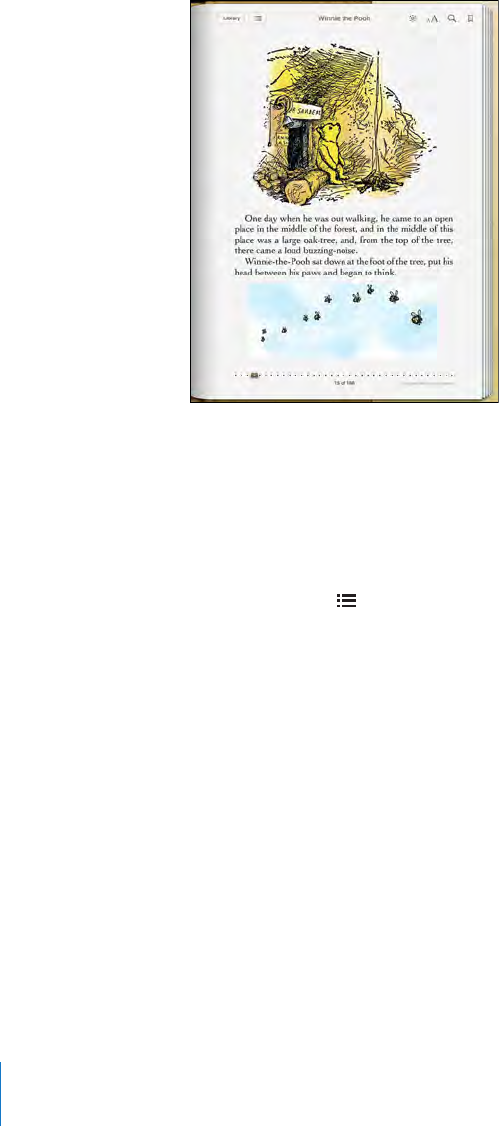
Reading Books
Reading a book is easy. Go to the bookshelf and tap the book you want to read. If you
don’t see the book you’re looking for, tap Collections to view other groups of books.
Turn pages: Tap near the right or left margin of a page, or ick left or right. To change
the direction the page turns when you tap the left margin, go to Settings > iBooks.
Go to a specic page: Tap near the center of the current page to show the controls.
Drag the page navigation control at the bottom of the screen to the desired page,
then let go.
Go to the table of contents: Tap near the center of the current page to show the
controls, then tap . Tap an entry to jump to that location, or tap Resume to return to
the current page.
Add or remove a bookmark: Tap the ribbon button to set a bookmark. You can have
multiple bookmarks. To remove a bookmark, tap it. You don’t need to add a bookmark
when you close a book, because iBooks remembers where you left o and returns
there when you open the book again.
Add, remove, or edit a highlight: Touch and hold any word until it’s selected. Use the
grab points to adjust the selection, then tap Highlight. To remove a highlight, tap the
highlighted text, then tap Remove Highlight. To change the color of a highlight, tap
the highlighted text, then tap Colors and select a color from the menu.
Add, view, or remove a note: Touch and hold any word until it’s selected. Use the grab
points to adjust the selection, then tap Note. Type some text, then tap Done. To view a
note, tap the indicator in the margin near the highlighted text. To remove a note, tap
the highlighted text, then choose Delete Note. To change the color of a note, tap the
highlighted text, then tap Colors and select a color from the menu.
126 Chapter 19 iBooks

See all your bookmarks, highlights and notes: To see the bookmarks, highlights, and
notes you’ve added, tap , then tap Bookmarks. To view a note, tap its indicator.
Enlarge an image: Double-tap an image.
To read a book while lying down, use the screen rotation lock to prevent iPad from
rotating the display when you tilt iPad. For information, see “Viewing in Portrait or
Landscape” on page 16.
Reading PDFs
You can use iBooks to read PDFs. Go to the bookshelf and tap Collections, select a
collection, then tap the PDF you want to read.
Turn pages: Flick left or right.
Enlarge a page: Pinch to zoom in on the page, then scroll to see the portion you want.
Go to a specic page: Tap near the center of the current page to show the controls.
Then, in the page navigation controls at the bottom of the page, drag until the desired
page number appears, or tap a thumbnail to jump to that page.
Add or remove a bookmark: To add a bookmark, tap the ribbon button. You can have
multiple bookmarks. To remove a bookmark, tap it. You don’t need to set a bookmark
when you close a PDF, because iBooks remembers where you left o and returns there
when you open the PDF again.
Go to the table of contents: Tap near the center of the current page to show the
controls, then tap . Tap an entry to jump to that location, or tap Resume to return to
the current page. If the author hasn’t dened a table of contents, you can tap a page
icon instead.
Changing a Book’s Appearance
To change the appearance of a book, access the controls by tapping near the center of
a page.
Change the font or type size: Tap , then in the list that appears, tap or to
reduce or enlarge the type size. To change the font, tap Fonts, then select one from the
list. Changing the font and size also changes text formatting.
Change the brightness: Tap , then adjust the brightness.
Change the page and type color: Tap , then turn the Sepia option on to change
the color of the page and type. This setting applies to all books.
You can change the way that iBooks justies the text of paragraphs in Settings > iBooks.
127
Chapter 19 iBooks

Searching Books and PDFs
You can search for the title or author of a book to quickly locate it on the bookshelf.
You can also search the contents of a book to nd all the references to a word or
phrase you’re interested in. You can also send a search to Wikipedia or Google to nd
other related resources.
Search for a book: Go to the bookshelf. Tap the status bar to scroll to the top of the
screen, then tap the magnifying glass. Enter a word that’s in the title of a book, or the
author’s name, then tap Search. Matching books appear on the bookshelf.
Search in a book: Open a book and tap near the center of the page to show the
controls. Tap the magnifying glass, then enter a search phrase and tap Search. Tap a
search result to go to that page in the book.
To send your search to Google or Wikipedia, tap Search Google or Search Wikipedia.
Safari opens and displays the result.
To quickly search for a word in a book, touch and hold the word, then tap Search.
Looking up the Denition of a Word
You can look up the denition of a word using the dictionary.
Look up a word: Select a word in a book, then tap Dictionary in the menu that
appears. Dictionaries may not be available for all languages.
Having a Book Read to You
If you have a visual impairment, you can use VoiceOver to read a book aloud. See
“VoiceOver” on page 138 .
Some books may not be compatible with VoiceOver.
Printing or Emailing a PDF
You can use iBooks to send a copy of a PDF via email, or to print all or a portion of the
PDF to a supported printer.
Email a PDF: Open the PDF, then tap and choose Email Document. A new message
appears with the PDF attached. Tap Send when you nish addressing and writing your
message.
Print a PDF: Open the PDF, then tap and choose Print. Select a printer and the
page range and number of copies, then tap Print. For information about supported
printers, see “Printing” on page 40.
You can only email or print PDFs. These options aren’t available for ePub books.
128 Chapter 19 iBooks

Organizing the Bookshelf
Use the bookshelf to browse your books and PDFs. You can also organize items
into collections.
Sort the bookshelf: Go to the bookshelf and tap , then select a sort method from
the choices at the bottom of the screen.
Rearrange items: Touch and hold a book or PDF, then drag it to a new location on
the bookshelf.
Delete an item from the bookshelf: Go to the bookshelf and tap Edit. Tap each book
or PDF that you want to delete so that a checkmark appears, then tap Delete. When
you nish deleting, tap Done. If you delete a book you purchased, you can download it
again from Purchases in iBookstore. If you’ve synced your device with your computer,
the book also remains in your iTunes Library.
Create, rename, or delete a collection: Tap Collections to display the collections list.
Tap New to add a new collection. To delete a collection tap Edit, then tap and tap
Delete. You can’t edit or remove the built-in Books and PDFs collections. To edit the
name of a collection, tap its name. When you nish, tap Done.
Move a book or PDF to a collection: Go to the bookshelf and tap Edit. Tap each book
or PDF that you want to move so that a checkmark appears, then tap Move and select
a collection. An item can be in only one collection at a time. When you add a book
or PDF to your bookshelf, it’s put in the Books or PDF collection. From there, you can
move it to a dierent collection. You might want to create collections for work and
school, for example, or for reference and leisure reading.
View a collection: Tap Collections, then tap an item in the list that appears.
129
Chapter 19 iBooks

Game Center 20
About Game Center
You can discover new games and share your game experiences with friends around
the world in Game Center.
Invite your friends to play, or use auto-match to nd other equally-matched
opponents. Check leaderboards to see who the best players are. Earn bonus points by
achieving specic accomplishments in a game.
Note: Game Center may not be available in all countries or regions, and the available
games may vary by country or region.
To use Game Center, you need an Internet connection and an Apple ID. If you already
have an iTunes Store, MobileMe, or other Apple account, you can use that Apple ID
with Game Center. If you don’t already have an Apple ID, you can create one in Game
Center, as described below.
Setting Up Game Center
When you rst open Game Center, you’re asked if you want to allow push notications.
Notications include alerts, sounds, and icon badges that let you know about Game
Center events, even if you’re not using Game Center. For example, you might receive
an alert that a friend has invited you to play a game.
Allow notications: Tap OK.
If you tap Don’t Allow, you won’t receive notications for Game Center. You can
turn notications on at a later time if you want, and you can specify what kinds of
notications you want to get.
130